Review and Editing of Unit Descriptions
Moderator: MOD_Command
RE: IDEA/PROPOSAL: Community creation/review of unit description
Here's a draft on the EL/M-2106 ATAR
OVERVIEW: The EL/M-2106 Advanced Tactical Acquisition Radar (ATAR) is a road mobile, 3-D medium-range AESA Air Defense radar, capable against low RCS targets. It operates in the D (NATO) "L" (IEEE) Band.
DETAILS: The EL/M-2106 ATAR can detect a wide variety of low RCS targets such as low flying fighter aircraft, helicopters, low velocity ultra-lights and UAVs. It is intended to operate either as a stand-alone radar or as part of a local air defense and surveillance system and can provide warning and target designation to AD systems through a wireless data link. It can also be used as a gap filler radar. It can simultaneously track up to 100 targets.
Specifications:
Frequency: 1-2 GHz (D Band)
Power output: 400 W; 1600 W Peak
PRF: ?? pps
Range Resolution: 30 m of range, 0.5 degrees bearing, 1 degree elevation
Runup time: ??minutes
Set up time: 15 min
Detection Range: 97 nm (instrumented)
59-38 nm (v. fighter aircraft)
21.5 nm (v. helos)
21.5-32 nm ( v. UAVs and ultralights)
NOTES: IOC 2007. Available as either a fixed site or truck tansportable. Users include India.
SOURCES: IAI. "ELM-2106 ATAR Tactical 3D Air Defense Radar." Accessed September 27, 2021. https://www.iai.co.il/p/elm-2106-atar ; https://www.deagel.com/Sensor%20Systems ... 3D/a001423 Accessed September 27, 2021. ;"Ancile." Ancile. Accessed September 27, 2021. https://www.deagel.com/Sensor%20Systems ... 3D/a001423. ; "ELM-2106 ATAR – Missile Defense Advocacy Alliance." Missile Defense Advocacy Alliance – Making the World a Safer Place. Accessed September 27, 2021. https://missiledefenseadvocacy.org/defe ... 2106-atar/. ; IAI. "ELM-2106 ATAR Tactical 3D Air Defense Radar." Accessed September 27, 2021. https://web.archive.org/web/20141025053 ... /38930.pdf
OVERVIEW: The EL/M-2106 Advanced Tactical Acquisition Radar (ATAR) is a road mobile, 3-D medium-range AESA Air Defense radar, capable against low RCS targets. It operates in the D (NATO) "L" (IEEE) Band.
DETAILS: The EL/M-2106 ATAR can detect a wide variety of low RCS targets such as low flying fighter aircraft, helicopters, low velocity ultra-lights and UAVs. It is intended to operate either as a stand-alone radar or as part of a local air defense and surveillance system and can provide warning and target designation to AD systems through a wireless data link. It can also be used as a gap filler radar. It can simultaneously track up to 100 targets.
Specifications:
Frequency: 1-2 GHz (D Band)
Power output: 400 W; 1600 W Peak
PRF: ?? pps
Range Resolution: 30 m of range, 0.5 degrees bearing, 1 degree elevation
Runup time: ??minutes
Set up time: 15 min
Detection Range: 97 nm (instrumented)
59-38 nm (v. fighter aircraft)
21.5 nm (v. helos)
21.5-32 nm ( v. UAVs and ultralights)
NOTES: IOC 2007. Available as either a fixed site or truck tansportable. Users include India.
SOURCES: IAI. "ELM-2106 ATAR Tactical 3D Air Defense Radar." Accessed September 27, 2021. https://www.iai.co.il/p/elm-2106-atar ; https://www.deagel.com/Sensor%20Systems ... 3D/a001423 Accessed September 27, 2021. ;"Ancile." Ancile. Accessed September 27, 2021. https://www.deagel.com/Sensor%20Systems ... 3D/a001423. ; "ELM-2106 ATAR – Missile Defense Advocacy Alliance." Missile Defense Advocacy Alliance – Making the World a Safer Place. Accessed September 27, 2021. https://missiledefenseadvocacy.org/defe ... 2106-atar/. ; IAI. "ELM-2106 ATAR Tactical 3D Air Defense Radar." Accessed September 27, 2021. https://web.archive.org/web/20141025053 ... /38930.pdf
“Do I not destroy my enemies when I make them my friends?” -Abraham Lincoln
RE: IDEA/PROPOSAL: Community creation/review of unit description
Still searching which text to put in and what to leave out, sorry that my sentences still crappy. Working on it  Happy to receive pointers to improve.
Happy to receive pointers to improve.
OVERVIEW: The Karel Doorman JSS (Joint Support Ship) is a logistic support. Able to replenish other units at sea. Main functions are RAS (2 positions), sea transport and Sea basing in the high-end warfare environment.
DETAILS: The Karel Doorman is a Multipurpose ship to support the full spectrum of naval operations, including humanitarian, disaster relief, amphibious, sealift and underway fleet support. Sealift cargo includes 730m2 ammunition storage, 1000m2 general storage, 8700m3 fuel (7700t F76, 1000t F44), 125m3 and 2350m2 vehicle cargo space with Ro-Ro for vehicles. With extra personal complement can be 300 pax. A hanger and 2 helicopter spots up to chinook size helicopters inncludingn Osprey A/C. The hanger can store 2 chinooks or 6 NH-90's or 3 Osprey's. Two LCVP's in davits. The sensor suite for AS/SS includes phased array radar, EO/IR and ESM, weapons includes CIWS and ECM for self-portectection. The class has Diesel generators, 2 shafts with fixed propellors.
SPECIFICATIONS:
Displacement: 27.800 tons (full)
Speed: 18 max
Engineering: 5x RR Bergen dieselgenerators, 2x 8900 kW Electro-engines
Range: 9800 nm @ 12 kts
Endurance:
Complement: Crew 120 to 171 up to 300 for marines, staff, medical, etc
NOTES: Unit is used in very close international cooperation with other NATO/EU countries. Karel Doorman has Role 3 hospital facilities with 30 beds, 2 operations rooms, 10 medium-care and 3 ICU.
SOURCES: "Zr.Ms. Karel Doorman (A833) specifications." Marineschepen. Last modified 02-07-21. https://marineschepen.nl/schepen/jss.html;
"A 833 HNMLS Karel Doorman." Seaforces online. Last Modified July-2019. https://www.seaforces.org/marint/Nether ... oorman.htm;
"Karel Doorman Multipurpose ship (2015)." Navpedia. Last Modified 2019. https://navypedia.org/ships/netherlands ... oorman.htm;
"USMC MV-22 Osprey LAnded Aboard Royal Netherlands Navy JSS Karel Doorman." Navel Recognition. Last Modified 19-6-21. https://www.navyrecognition.com/index.p ... orman.html
OVERVIEW: The Karel Doorman JSS (Joint Support Ship) is a logistic support. Able to replenish other units at sea. Main functions are RAS (2 positions), sea transport and Sea basing in the high-end warfare environment.
DETAILS: The Karel Doorman is a Multipurpose ship to support the full spectrum of naval operations, including humanitarian, disaster relief, amphibious, sealift and underway fleet support. Sealift cargo includes 730m2 ammunition storage, 1000m2 general storage, 8700m3 fuel (7700t F76, 1000t F44), 125m3 and 2350m2 vehicle cargo space with Ro-Ro for vehicles. With extra personal complement can be 300 pax. A hanger and 2 helicopter spots up to chinook size helicopters inncludingn Osprey A/C. The hanger can store 2 chinooks or 6 NH-90's or 3 Osprey's. Two LCVP's in davits. The sensor suite for AS/SS includes phased array radar, EO/IR and ESM, weapons includes CIWS and ECM for self-portectection. The class has Diesel generators, 2 shafts with fixed propellors.
SPECIFICATIONS:
Displacement: 27.800 tons (full)
Speed: 18 max
Engineering: 5x RR Bergen dieselgenerators, 2x 8900 kW Electro-engines
Range: 9800 nm @ 12 kts
Endurance:
Complement: Crew 120 to 171 up to 300 for marines, staff, medical, etc
NOTES: Unit is used in very close international cooperation with other NATO/EU countries. Karel Doorman has Role 3 hospital facilities with 30 beds, 2 operations rooms, 10 medium-care and 3 ICU.
SOURCES: "Zr.Ms. Karel Doorman (A833) specifications." Marineschepen. Last modified 02-07-21. https://marineschepen.nl/schepen/jss.html;
"A 833 HNMLS Karel Doorman." Seaforces online. Last Modified July-2019. https://www.seaforces.org/marint/Nether ... oorman.htm;
"Karel Doorman Multipurpose ship (2015)." Navpedia. Last Modified 2019. https://navypedia.org/ships/netherlands ... oorman.htm;
"USMC MV-22 Osprey LAnded Aboard Royal Netherlands Navy JSS Karel Doorman." Navel Recognition. Last Modified 19-6-21. https://www.navyrecognition.com/index.p ... orman.html
RE: IDEA/PROPOSAL: Community creation/review of unit description
DB3000 #2797 AOPS 430 Harry DeWolf (Navy), 2021
Overview: The Arctic and Offshore Patrol Ships (AOPS), designated the Harry DeWolf-class, are intended to conduct armed seaborne surveillance and sovereignty in Canada’s exclusive economic zone (EEZ), as well as on the Atlantic, Pacific, and Arctic coasts. In addition, they have been designed to operate in tropical theatres like the Caribbean and Mediterranean with a range of more than 6000 nautical miles, patrol duration of 4 months and the ability to operate in Sea State 4 and to penetrate ice up to 1m thick.
DETAILS: The hull of the Harry DeWolf-Class vessels is designed to meet the International Association of Classification Societies (IACS) Polar Class (PC) 5+ requirements. Each vessel will have a length of 97m, beam of 19m, draught of 5.7m and displacement of 6,400t. It will accommodate a crew of 65 members. The vessels can carry two 8.5m-long multi-purpose rescue boats with a maximum speed of more than 35k for rescue, personnel transfer and boarding missions, two 12m RCMP/JTF2/Navy mission-fit boarding/assault boats and a 12 metre landing craft. The vehicle bay houses pick-up trucks, all-terrain vehicles (ATVs) and snowmobiles. The ships are lightly armed with an armament of 1x 25/75 BAE Mk 38, and 2x 12.7/90. The flight deck, supports the operation of a variety of helicopters, ranging from a small utility aircraft to the Royal Canadian Air Force’s CH-148 Cyclone maritime helicopter and the Coast Guard's CH-149 Cormorant. The AOPS can also be integrated with payloads such as underwater survey equipment and shipping containers. A 20t crane with self-loading and unloading capability is also fitted on the ship.
Specifications:
Length 103 metres, Beam(width) 19 metres
Displacement: 6400t (full)
Speed: 17kts
Machinery: 4 diesel-generators, 2 electric motors
Endurance: 6,800nm(14kts)
Complement: 65
Hulls built: 2, +4 building
Period of Service: 2021-
Sources:
http://www.navy-marine.forces.gc.ca/en/fleet-units/aops-home.page
https://en.wikipedia.org/wiki/HMCS_Harry_DeWolf
https://www.naval-technology.com/projects/harry-dewolf-class-arcticoffshore-patrol-ships-aops/
http://www.navypedia.org/ships/canada/can_es_harry_dewolf.htm
https://www.tpsgc-pwgsc.gc.ca/app-acq/amd-dp/mer-sea/sncn-nss/npea-aops-eng.html
https://maritime-executive.com/article/landing-craft-for-canada-s-aops-complete-sea-trials
NOTES: 2x additional units will be built for the Canadian Coast Guard, they will be unarmed and have scientific labs onboard.
https://www.tpsgc-pwgsc.gc.ca/app-acq/amd-dp/mer-sea/sncn-nss/arctique-coastgd-eng.html
NAVY
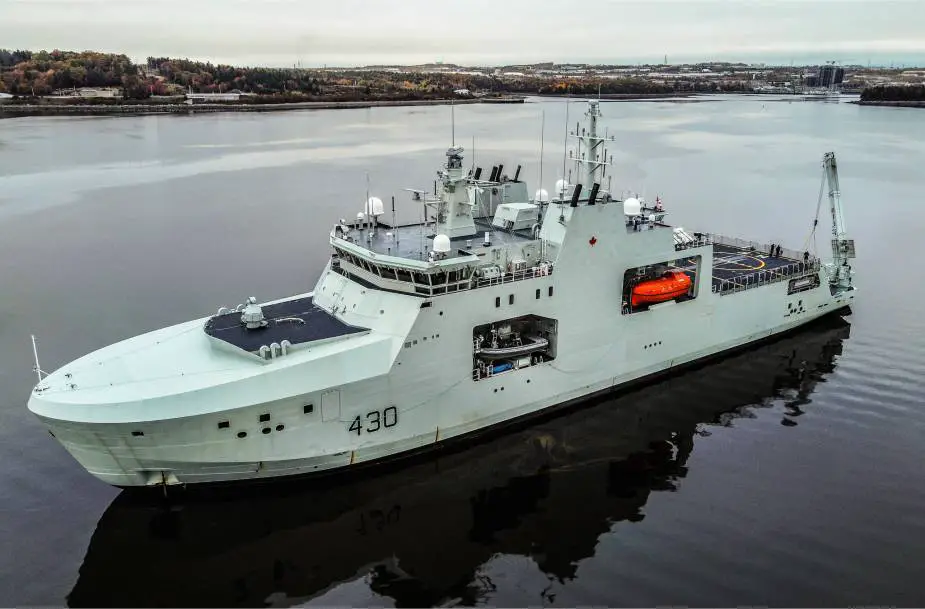
Coast Guard
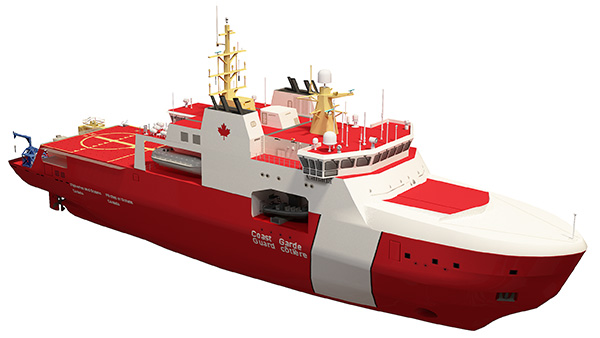
Overview: The Arctic and Offshore Patrol Ships (AOPS), designated the Harry DeWolf-class, are intended to conduct armed seaborne surveillance and sovereignty in Canada’s exclusive economic zone (EEZ), as well as on the Atlantic, Pacific, and Arctic coasts. In addition, they have been designed to operate in tropical theatres like the Caribbean and Mediterranean with a range of more than 6000 nautical miles, patrol duration of 4 months and the ability to operate in Sea State 4 and to penetrate ice up to 1m thick.
DETAILS: The hull of the Harry DeWolf-Class vessels is designed to meet the International Association of Classification Societies (IACS) Polar Class (PC) 5+ requirements. Each vessel will have a length of 97m, beam of 19m, draught of 5.7m and displacement of 6,400t. It will accommodate a crew of 65 members. The vessels can carry two 8.5m-long multi-purpose rescue boats with a maximum speed of more than 35k for rescue, personnel transfer and boarding missions, two 12m RCMP/JTF2/Navy mission-fit boarding/assault boats and a 12 metre landing craft. The vehicle bay houses pick-up trucks, all-terrain vehicles (ATVs) and snowmobiles. The ships are lightly armed with an armament of 1x 25/75 BAE Mk 38, and 2x 12.7/90. The flight deck, supports the operation of a variety of helicopters, ranging from a small utility aircraft to the Royal Canadian Air Force’s CH-148 Cyclone maritime helicopter and the Coast Guard's CH-149 Cormorant. The AOPS can also be integrated with payloads such as underwater survey equipment and shipping containers. A 20t crane with self-loading and unloading capability is also fitted on the ship.
Specifications:
Length 103 metres, Beam(width) 19 metres
Displacement: 6400t (full)
Speed: 17kts
Machinery: 4 diesel-generators, 2 electric motors
Endurance: 6,800nm(14kts)
Complement: 65
Hulls built: 2, +4 building
Period of Service: 2021-
Sources:
http://www.navy-marine.forces.gc.ca/en/fleet-units/aops-home.page
https://en.wikipedia.org/wiki/HMCS_Harry_DeWolf
https://www.naval-technology.com/projects/harry-dewolf-class-arcticoffshore-patrol-ships-aops/
http://www.navypedia.org/ships/canada/can_es_harry_dewolf.htm
https://www.tpsgc-pwgsc.gc.ca/app-acq/amd-dp/mer-sea/sncn-nss/npea-aops-eng.html
https://maritime-executive.com/article/landing-craft-for-canada-s-aops-complete-sea-trials
NOTES: 2x additional units will be built for the Canadian Coast Guard, they will be unarmed and have scientific labs onboard.
https://www.tpsgc-pwgsc.gc.ca/app-acq/amd-dp/mer-sea/sncn-nss/arctique-coastgd-eng.html
NAVY

Coast Guard

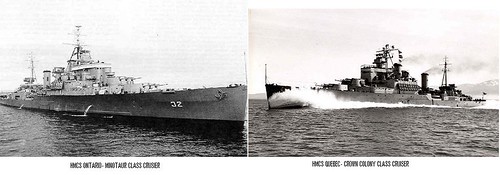
RE: IDEA/PROPOSAL: Community creation/review of unit description
#3223 AOR MV Asterix, Resolve Class(Leased), 2018
Overview: The Resolve-class auxiliary oiler replenishment (AOR) vessel is a retrofit of the MS Asterix container vessel to support the Royal Canadian Navy’s at-sea replenishment capability. Delivery of the ship was made in December 2017.
Detail: Designed in accordance with Lloyds Register classification standards, the Resolve-class ship is intended to supply ammunition, fuel, food, water, power, and spare parts to the Canadian naval forces at sea. It can also be used for humanitarian assistance and disaster relief missions. As part of the conversion project, Project Resolve consortium was contracted to rebuild and equip the MV Asterix vessel with naval technology to military specifications. The Resolve-class auxiliary oiler replenishment ship features double-hull design with a bulbous bow. The supply ship accommodates 150 crew members and up to 350 humanitarian assistance and disaster relief personnel. Its accommodation section has space for briefing, and conference rooms for command and control functions. A large flight deck is provided at the stern to support ship-to-shore airlift operations conducted by two embarked Cyclone CH-148 helicopters, which will be housed in two hangars located next to the accommodation unit.
Up to four NATO STREAM-type replenishment-at-sea masts are installed amidships to refuel and resupply two ships simultaneously at sea in difficult weather conditions. The supply ship is capable of transporting 10,500m³ of F76 marine diesel fuel, 1,300m³ of F44 aviation fuel, 400t/day of fresh water, 300t of ammunition, and significant power. The fuel will be stored in pre-fabricated tanks featuring triple-protection walls. A vehicle bay located on tween-deck is intended for carriage of trucks, light armoured vehicles and jeeps. The bow section has a protected containerised storage area for storing 38 containers, including 20 refrigerated, ammunition and supplies. The containers can be loaded or unloaded using two 30t cargo cranes.
Specifications:
Length: 182.5m, Beam 25.2m (width)
Displacement: 26,000t (full)
Speed: 22kts
Machinery: MAN 7S60 MC-C Mk8, 16,660 kW (22,340 hp), bow thruster
Endurance: 10,000nm
Complement: 150 +350 (HaDR)
Armament: (provisions for, but not fitted with) 3 × Phalanx CIWS
Aviation facilities: aft deck - 1 landing spot and 2 hangars capable of holding Chinook size helicopters
Helicopter: 2 x CH-148
Stores: F76 (Marine Diesel) 10,500m3, F44 (Aviation Fuel) 1,300m3
RAS Masts: 4 STREAM type
Hospital: NATO 2E
Small craft: 8 assorted (4x RHIB, 2x Fast Rescue Craft, 2x Lifeboats, 2x LCVP)
Hulls built: 1
Period of Service: 2018-
Sources:
https://www.navy-marine.forces.gc.ca/assets/NAVY_Internet/docs/en/news/rcn_iaor-fs_eng.pdf
https://www.globalsecurity.org/military/world/canada/hmcs-aor-asterix-specs.htm
https://en.wikipedia.org/wiki/Project_Resolve
https://en.wikipedia.org/wiki/MV_Asterix
http://federalfleet.ca/2016/06/02/resolve-class-aor/
https://www.naval-technology.com/projects/resolve-class-auxiliary-oiler-replenishment-aor-vessel/
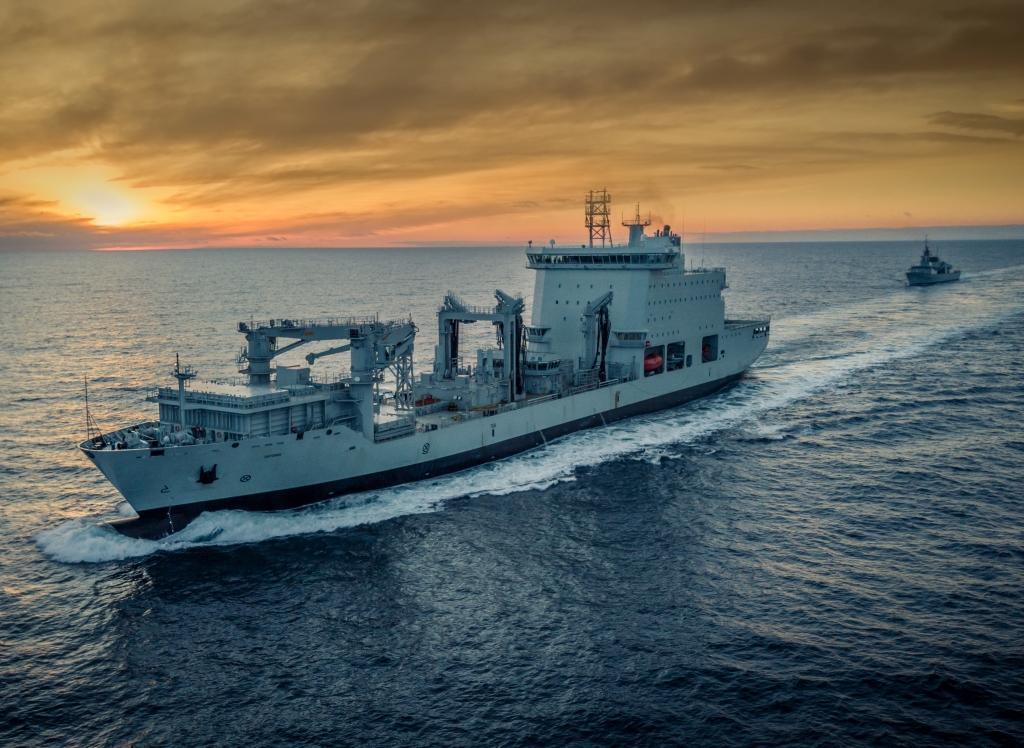
Overview: The Resolve-class auxiliary oiler replenishment (AOR) vessel is a retrofit of the MS Asterix container vessel to support the Royal Canadian Navy’s at-sea replenishment capability. Delivery of the ship was made in December 2017.
Detail: Designed in accordance with Lloyds Register classification standards, the Resolve-class ship is intended to supply ammunition, fuel, food, water, power, and spare parts to the Canadian naval forces at sea. It can also be used for humanitarian assistance and disaster relief missions. As part of the conversion project, Project Resolve consortium was contracted to rebuild and equip the MV Asterix vessel with naval technology to military specifications. The Resolve-class auxiliary oiler replenishment ship features double-hull design with a bulbous bow. The supply ship accommodates 150 crew members and up to 350 humanitarian assistance and disaster relief personnel. Its accommodation section has space for briefing, and conference rooms for command and control functions. A large flight deck is provided at the stern to support ship-to-shore airlift operations conducted by two embarked Cyclone CH-148 helicopters, which will be housed in two hangars located next to the accommodation unit.
Up to four NATO STREAM-type replenishment-at-sea masts are installed amidships to refuel and resupply two ships simultaneously at sea in difficult weather conditions. The supply ship is capable of transporting 10,500m³ of F76 marine diesel fuel, 1,300m³ of F44 aviation fuel, 400t/day of fresh water, 300t of ammunition, and significant power. The fuel will be stored in pre-fabricated tanks featuring triple-protection walls. A vehicle bay located on tween-deck is intended for carriage of trucks, light armoured vehicles and jeeps. The bow section has a protected containerised storage area for storing 38 containers, including 20 refrigerated, ammunition and supplies. The containers can be loaded or unloaded using two 30t cargo cranes.
Specifications:
Length: 182.5m, Beam 25.2m (width)
Displacement: 26,000t (full)
Speed: 22kts
Machinery: MAN 7S60 MC-C Mk8, 16,660 kW (22,340 hp), bow thruster
Endurance: 10,000nm
Complement: 150 +350 (HaDR)
Armament: (provisions for, but not fitted with) 3 × Phalanx CIWS
Aviation facilities: aft deck - 1 landing spot and 2 hangars capable of holding Chinook size helicopters
Helicopter: 2 x CH-148
Stores: F76 (Marine Diesel) 10,500m3, F44 (Aviation Fuel) 1,300m3
RAS Masts: 4 STREAM type
Hospital: NATO 2E
Small craft: 8 assorted (4x RHIB, 2x Fast Rescue Craft, 2x Lifeboats, 2x LCVP)
Hulls built: 1
Period of Service: 2018-
Sources:
https://www.navy-marine.forces.gc.ca/assets/NAVY_Internet/docs/en/news/rcn_iaor-fs_eng.pdf
https://www.globalsecurity.org/military/world/canada/hmcs-aor-asterix-specs.htm
https://en.wikipedia.org/wiki/Project_Resolve
https://en.wikipedia.org/wiki/MV_Asterix
http://federalfleet.ca/2016/06/02/resolve-class-aor/
https://www.naval-technology.com/projects/resolve-class-auxiliary-oiler-replenishment-aor-vessel/


RE: IDEA/PROPOSAL: Community creation/review of unit description
OVERVIEW: The Mercuur is a Submarine support and training ship capable of firing and recovering (exercise) torpedoes. She also acts frequently as staff ship for MCM operations.
DETAILS: Training also consists of torpedo exercises with above water units and as OPFOR and target ship. Sonsors are I-band navigation radar and a passive sonar. There is space to fit two 20mm MG's, Torpedo tubes of 324mm (above water) & 533mm (underwater). She has a RIB (Rigid Inflatable Boat) for recovering torpedoes. Refit in 2015.
SPECIFICATIONS:
Displacement: 1500 full
Speed: 14 (max)
Engineering: 2 MAN 6L-20/27 diesels
Range: ?
Endurance: ?
Complement: Crew 28 with 11 spares
NOTES: HNLMS Mercuur is primary not designed as warwafe capable ship to reduce costs and has more civil parts
SOURCES:"HNLMS Mercuur (A900) Torpedo workship." Marineschepen. Last Modified:8-5-20 .https://marineschepen.nl/schepen/mercuur.html;
"HNLMS Mercuur (A900)." Wikipedia. Last Modified: 24-11-20. https://en.wikipedia.org/wiki/HNLMS_Mercuur_(A900);
"Refit RNLN torpedo ship Zr Ms Mercuur by Damen." Naval Recognition. Last Modified: 21-5-15. https://www.navyrecognition.com/index.p ... damen.html
DETAILS: Training also consists of torpedo exercises with above water units and as OPFOR and target ship. Sonsors are I-band navigation radar and a passive sonar. There is space to fit two 20mm MG's, Torpedo tubes of 324mm (above water) & 533mm (underwater). She has a RIB (Rigid Inflatable Boat) for recovering torpedoes. Refit in 2015.
SPECIFICATIONS:
Displacement: 1500 full
Speed: 14 (max)
Engineering: 2 MAN 6L-20/27 diesels
Range: ?
Endurance: ?
Complement: Crew 28 with 11 spares
NOTES: HNLMS Mercuur is primary not designed as warwafe capable ship to reduce costs and has more civil parts
SOURCES:"HNLMS Mercuur (A900) Torpedo workship." Marineschepen. Last Modified:8-5-20 .https://marineschepen.nl/schepen/mercuur.html;
"HNLMS Mercuur (A900)." Wikipedia. Last Modified: 24-11-20. https://en.wikipedia.org/wiki/HNLMS_Mercuur_(A900);
"Refit RNLN torpedo ship Zr Ms Mercuur by Damen." Naval Recognition. Last Modified: 21-5-15. https://www.navyrecognition.com/index.p ... damen.html
RE: IDEA/PROPOSAL: Community creation/review of unit description
Draft MiG-23MS Flogger H for comment by the community. There isn't too much to write about regarding the Flogger H. If anyone has any interesting "factoids" that might be interesting to the player, please let me know, and I'll add it.
OVERVIEW: The MiG-23BN aka Flogger H is a single engine, variable-geometry, supersonic 3rd generation fighter-bomber.
DETAILS: The MiG-23B series of fighter-bombers were intended to replace the inadequate MiG-17 and Su-7s that were filling the attack role in the 1960's. The initial small production version of the fighter bomber was the MiG-23B. After only about 24 aircraft were produced, it was superseded by the MiG-23BN/Flogger H.
The Flogger H lacked the HIGH LARK radar used by the MiG-23 fighters. Instead, it had the Sokol-23N nav-attack system. It also included the internal SPS-141 Siren jammer that was optimized for use against the fire control radar of the Hawk an Nike-Hercules SAMs. The MiG-23's small profile made it hard to visually spot.
The aircraft was powered by an R-29B-300 turbojet engine, producing 23,370 lb of thrust.
NOTES: IOC 1973 (approx.) Approximately 624 MiG-23BNs were built from 1973-1985, mostly for export. The "A" subvarient was almost identical to the Soviet version, and was exclusively for export to Warsaw Pact countries. The "B" subvarient featured downgraded countermeasures gear and avionics; it was provided to Algeria, Cuba, Egypt, Ethiopia, India, Iraq, Libya, and Syria.
SOURCE: "MiG-23M." Airwar.Ru. Accessed September 20, 2021. https://www.airwar.ru/enc/fighter/mig23m.html. ; Mladenov, Alexander. Soviet Cold War Fighters. Fonthill Media, 2017. ; Newdick, Thomas. "This Myth-Busting Walk-Around Of The Soviet MiG-23 Flogger Fighter Is A Must-Watch." The Drive. Last modified March 18, 2021. https://www.thedrive.com/the-war-zone/3 ... must-watch. ; "MiG-23ML." Airwar.Ru.Accessed September 20, 2021. https://www.airwar.ru/enc/fighter/mig23ml.html ; Davies, Steve. Red Eagles: America’s Secret MiGs. Oxford: Osprey Publishing, 2008 pg. 167 ; "Mikoyan MIG-23." Weapons and Warfare. Last modified November 14, 2020. https://weaponsandwarfare.com/2020/11/2 ... an-mig-23/. ; "[2.0] Attack & Trainer Floggers." AirVectors. Accessed September 28, 2021. https://www.airvectors.net/avmig23_2.html. ;
Skyfire85, Skyfire77 A. "Flightline: 190 - MiG-23 (NATO Reporting Name: Flogger)." DriveTribe. Last modified August 4, 2021. https://drivetribe.com/p/flightline-190 ... iWEja89oiQ.
OVERVIEW: The MiG-23BN aka Flogger H is a single engine, variable-geometry, supersonic 3rd generation fighter-bomber.
DETAILS: The MiG-23B series of fighter-bombers were intended to replace the inadequate MiG-17 and Su-7s that were filling the attack role in the 1960's. The initial small production version of the fighter bomber was the MiG-23B. After only about 24 aircraft were produced, it was superseded by the MiG-23BN/Flogger H.
The Flogger H lacked the HIGH LARK radar used by the MiG-23 fighters. Instead, it had the Sokol-23N nav-attack system. It also included the internal SPS-141 Siren jammer that was optimized for use against the fire control radar of the Hawk an Nike-Hercules SAMs. The MiG-23's small profile made it hard to visually spot.
The aircraft was powered by an R-29B-300 turbojet engine, producing 23,370 lb of thrust.
NOTES: IOC 1973 (approx.) Approximately 624 MiG-23BNs were built from 1973-1985, mostly for export. The "A" subvarient was almost identical to the Soviet version, and was exclusively for export to Warsaw Pact countries. The "B" subvarient featured downgraded countermeasures gear and avionics; it was provided to Algeria, Cuba, Egypt, Ethiopia, India, Iraq, Libya, and Syria.
SOURCE: "MiG-23M." Airwar.Ru. Accessed September 20, 2021. https://www.airwar.ru/enc/fighter/mig23m.html. ; Mladenov, Alexander. Soviet Cold War Fighters. Fonthill Media, 2017. ; Newdick, Thomas. "This Myth-Busting Walk-Around Of The Soviet MiG-23 Flogger Fighter Is A Must-Watch." The Drive. Last modified March 18, 2021. https://www.thedrive.com/the-war-zone/3 ... must-watch. ; "MiG-23ML." Airwar.Ru.Accessed September 20, 2021. https://www.airwar.ru/enc/fighter/mig23ml.html ; Davies, Steve. Red Eagles: America’s Secret MiGs. Oxford: Osprey Publishing, 2008 pg. 167 ; "Mikoyan MIG-23." Weapons and Warfare. Last modified November 14, 2020. https://weaponsandwarfare.com/2020/11/2 ... an-mig-23/. ; "[2.0] Attack & Trainer Floggers." AirVectors. Accessed September 28, 2021. https://www.airvectors.net/avmig23_2.html. ;
Skyfire85, Skyfire77 A. "Flightline: 190 - MiG-23 (NATO Reporting Name: Flogger)." DriveTribe. Last modified August 4, 2021. https://drivetribe.com/p/flightline-190 ... iWEja89oiQ.
“Do I not destroy my enemies when I make them my friends?” -Abraham Lincoln
RE: IDEA/PROPOSAL: Community creation/review of unit description
#3387
Not sure what the Mid-life update is gonna be.
OVERVIEW: Johan de Witt is a Landing Platform Dock Amphibious warfare ship with large staff & logistics capabilities.
DETAILS: The Johan de Witt is a DieselElectric-powered Multipurpose ship with pods to act in the high-end warfare. Operations includes humanitarian, disaster relief, sealift and amphibious operations.
Logistics, the RoRo space is 2100m2 for up to 170 vehicles or 33 tanks and another 770m2 for cargo/ammo, with a 25t crane. 4x LCA or 2x LCU in well deck, 4x LCVP or 12m RHIB in davits And 1 small 7m RHIB under the crane. Can also accommodate FRISC, LCAC and have provissions for CB90.
Aviation facilities include a hanger and a large flightdeck (58x25m) with two landing spots. The Hanger can hold 6xNH90 or 4xEH101, other helicopters onboard can be Chinook, Cougar, Osprey and all similar in characteristics.
For Amphibious operations she can hold 555 marines. The spare beds can also be used for medical personal, evacues, etc. The Johan de Witt is equipt with Operation rooms, ICU, Laboratory and X-ray.
The sensor suite includes AS/SS radar & LPI nav radar with EO/IR and ESM sensors, weapons are 12.7 mm MG, CIWS and ECM for self-protection.
SPECIFICATIONS:
Displacement: 15000 tons (full)
Speed: 19.5 kts
Engineering: 4 x Stork Warstila diesels (14.6MW), 2 x Holec Electric motors (11MW), 2 Schottel SEP 5 Electric Propulsor Pods
Range: 6000 nm @ 12 kts, 10000 @ 12
Endurance: 30 days with 555 marines onboard + 10 days support after marines ashore
Complement: 146 Crew & 555 extra for staff, marines, medical personal or evacues
NOTES: Johan de Witt is an evolved build of HNLMS Rotterdam
SOURCES:"Johan de Witt Landing Platform Dock." Marineschepen. Last Modified:24-4-21 . https://marineschepen.nl/schepen/johandewitt.html#specs;
SOURCES:"L801 HNLMS Johan de Witt." seaforces. Last Modified:Jul-2019 . https://seaforces.org/marint/Netherland ... e-Witt.htm
SOURCES:"Johan de Witt Amphibious transport dock." Navpedia. Last Modified:2019 . https://navypedia.org/ships/netherlands ... e_witt.htm
best regards GJ
Not sure what the Mid-life update is gonna be.
OVERVIEW: Johan de Witt is a Landing Platform Dock Amphibious warfare ship with large staff & logistics capabilities.
DETAILS: The Johan de Witt is a DieselElectric-powered Multipurpose ship with pods to act in the high-end warfare. Operations includes humanitarian, disaster relief, sealift and amphibious operations.
Logistics, the RoRo space is 2100m2 for up to 170 vehicles or 33 tanks and another 770m2 for cargo/ammo, with a 25t crane. 4x LCA or 2x LCU in well deck, 4x LCVP or 12m RHIB in davits And 1 small 7m RHIB under the crane. Can also accommodate FRISC, LCAC and have provissions for CB90.
Aviation facilities include a hanger and a large flightdeck (58x25m) with two landing spots. The Hanger can hold 6xNH90 or 4xEH101, other helicopters onboard can be Chinook, Cougar, Osprey and all similar in characteristics.
For Amphibious operations she can hold 555 marines. The spare beds can also be used for medical personal, evacues, etc. The Johan de Witt is equipt with Operation rooms, ICU, Laboratory and X-ray.
The sensor suite includes AS/SS radar & LPI nav radar with EO/IR and ESM sensors, weapons are 12.7 mm MG, CIWS and ECM for self-protection.
SPECIFICATIONS:
Displacement: 15000 tons (full)
Speed: 19.5 kts
Engineering: 4 x Stork Warstila diesels (14.6MW), 2 x Holec Electric motors (11MW), 2 Schottel SEP 5 Electric Propulsor Pods
Range: 6000 nm @ 12 kts, 10000 @ 12
Endurance: 30 days with 555 marines onboard + 10 days support after marines ashore
Complement: 146 Crew & 555 extra for staff, marines, medical personal or evacues
NOTES: Johan de Witt is an evolved build of HNLMS Rotterdam
SOURCES:"Johan de Witt Landing Platform Dock." Marineschepen. Last Modified:24-4-21 . https://marineschepen.nl/schepen/johandewitt.html#specs;
SOURCES:"L801 HNLMS Johan de Witt." seaforces. Last Modified:Jul-2019 . https://seaforces.org/marint/Netherland ... e-Witt.htm
SOURCES:"Johan de Witt Amphibious transport dock." Navpedia. Last Modified:2019 . https://navypedia.org/ships/netherlands ... e_witt.htm
best regards GJ
RE: IDEA/PROPOSAL: Community creation/review of unit description
ORIGINAL: CV60
Draft MiG-23BN Flogger H for comment by the community. There isn't too much to write about regarding the Flogger H. If anyone has any interesting "factoids" that might be interesting to the player, please let me know, and I'll add it.
...
Although not implemented in the game now the SPS-141 ECM covers only frontal aspect of MiG-23BN due to antennas installation in front of the aircraft. May be this information could be added here.
RE: IDEA/PROPOSAL: Community creation/review of unit description
quote:
ORIGINAL: CV60
Draft MiG-23BN Flogger H for comment by the community. There isn't too much to write about regarding the Flogger H. If anyone has any interesting "factoids" that might be interesting to the player, please let me know, and I'll add it.
...
Although not implemented in the game now the SPS-141 ECM covers only frontal aspect of MiG-23BN due to antennas installation in front of the aircraft. May be this information could be added here.
Thanks. I will add that. (That is one of the good things about the description files-We can put things here that are true, but are not yet implemented in the game). If you have a source for that infor, I will add it to the "Sources" file
“Do I not destroy my enemies when I make them my friends?” -Abraham Lincoln
RE: IDEA/PROPOSAL: Community creation/review of unit description
ORIGINAL: CV60
Instead, it had the Sokol-23N nav-attack system.
A little more details. Mig-23BN had navigation system KN-23, attack system Sokol-23S (Сокол, Hawk) consists of bomb sight PBK-3-23S, gun (optical) sign ASP-17, laser rangefinder "Fon" ("Фон", Background).
The laser rangefinder "Fon" has range 400 - 5000 m, instrumental error 30 m.
The KH-23 system provided automatic flight on a route with three waypoints and ingress to the target. Memorize up to four landing airfields, provides flight and approach to landing to 40-50 m altitude.
https://studfile.net/preview/6169435/
Teaching material on KN-23
SPS-141 illuminates in forward hemisphere.
I Band (8-10 GHz) [Old X Band] 3-3.75 cm
http://bastion-karpenko.ru/sps-141-siren-reb/
RE: IDEA/PROPOSAL: Community creation/review of unit description
#3018 AOR 508 Provider, 1964-98
Overview: Commissioned on September 28, 1963 this ship was the first dedicated replenishment ship built for the Canadian Navy and at construction was the largest ship built for the RCN.
Details: The ship was designed with the capacity for the stowage of fuel, ammunition, supplies, provisions (dry and refrigerated) and replacement helicopters. She had 26 fuel cargo tanks which held approximately 14,000 tons of FFO, 1,500 tons of diesel and 900 tons of aviation gas (JP5) along with 430 tons of ammunition, provisions and spare parts.
Specifications:
Displacement: 22,700 tons full load
Dimensions: 168 x 23.17 x 9.5 meters (551 x 76 x 31 feet)
Propulsion: 2 water tube boilers, double reduction geared turbine, 1 shaft, 21,000 shp, 20 knots
Crew: 166
Aviation: aft helicopter deck with hangar; 3 CH-124A Sea King helicopters
Cargo: 14,200 tons fuel, 250 tons munitions, provisions, spares
Notes: Originally posted on the East coast, her exposed lower deck made her unsuited for the North Atlantic, she was transferred to the West coast when the first of the two new Protecteur replenishment vessels became available in 1969.
Sources:
http://www.hazegray.org/navhist/canada/ ... /provider/
http://www.forposterityssake.ca/Navy/HM ... ER_508.htm
https://en.wikipedia.org/wiki/HMCS_Provider_(AOR_508)

Overview: Commissioned on September 28, 1963 this ship was the first dedicated replenishment ship built for the Canadian Navy and at construction was the largest ship built for the RCN.
Details: The ship was designed with the capacity for the stowage of fuel, ammunition, supplies, provisions (dry and refrigerated) and replacement helicopters. She had 26 fuel cargo tanks which held approximately 14,000 tons of FFO, 1,500 tons of diesel and 900 tons of aviation gas (JP5) along with 430 tons of ammunition, provisions and spare parts.
Specifications:
Displacement: 22,700 tons full load
Dimensions: 168 x 23.17 x 9.5 meters (551 x 76 x 31 feet)
Propulsion: 2 water tube boilers, double reduction geared turbine, 1 shaft, 21,000 shp, 20 knots
Crew: 166
Aviation: aft helicopter deck with hangar; 3 CH-124A Sea King helicopters
Cargo: 14,200 tons fuel, 250 tons munitions, provisions, spares
Notes: Originally posted on the East coast, her exposed lower deck made her unsuited for the North Atlantic, she was transferred to the West coast when the first of the two new Protecteur replenishment vessels became available in 1969.
Sources:
http://www.hazegray.org/navhist/canada/ ... /provider/
http://www.forposterityssake.ca/Navy/HM ... ER_508.htm
https://en.wikipedia.org/wiki/HMCS_Provider_(AOR_508)


RE: IDEA/PROPOSAL: Community creation/review of unit description
#396, #1398 AOR 509 Protecteur
Overview: HMCS Protecteur is a Canadian "Protecteur"-class Auxiliary Oiler Replenishment (replenishment oiler) ship. Built by Saint John Shipbuilding and Dry Docks in Saint John, New Brunswick, she was commissioned in 1969, the first ship of her class.
Details: Protecteur class ships are deployed to supply fuel, food and ammunitions to Canadian and allied warships at sea. The vessel’s displacement is five times greater than that of a frigate. This allows it to supply provisions to a group of six destroyers for six weeks without returning to port for resupply. The ships are also equipped with modern medical equipment making them ideal for disaster response and support duties.
Specifications:
Displacement: 24,000tonnes fully loaded
Dimensions: Length 171.9m, beam 23.2, draught 10.1m
Propulsion: 2 × Babcock & Wilcox boilers, 1 × General Electric steam turbine engine at 21,000 shp (16,000 kW)
Crew: 365 officers and crew, including 45 in air detachment
Aviation: aft helicopter deck with hangar; up to 3 CH-124 Sea King helicopters
Cargo: 14,590 t (14,360 long tons) of fuel, 400 t (394 long tons) of aviation fuel, 1,048 t (1,031 long tons) of dry cargo, and 1,250 t (1,230 long tons) of ammunition, spares
Armament: 1 x FMC 3”/50 (later removed), 1 Mk.29 octuple Sea Sparrow (fitted for but not with), 6 × .50 calibre machine guns
NOTES: The Canadian Navy never purchased any Mk.29 Sea Sparrow launchers for these ships but the design originally allowed for them.
Sources:
http://www.hazegray.org/navhist/canada/current/protect/
https://en.wikipedia.org/wiki/Protecteu ... ment_oiler
https://readyayeready.com/ships/shipvie ... PROTECTEUR
https://www.naval-technology.com/projec ... eur-class/
#722 AOR 509 Protecteur, 1990, (Gulf War)
Overview: HMCS Protecteur is a Canadian "Protecteur"-class Auxiliary Oiler Replenishment (replenishment oiler) ship. Built by Saint John Shipbuilding and Dry Docks in Saint John, New Brunswick, she was commissioned in 1969, the first ship of her class.
Details: Protecteur departed Halifax on 24 August 1990 for Operation Friction with her bow 3-inch/50 re-installed, as well as two CIWS mounts (permanent post conflict), two Bofors 40mm guns, six 0.5 inch (12.7mm) machine guns as well as Blowpipe and Javelin MAPADS during the Gulf War deployment. Countermeasures & decoys added for the mission included 4 × BAE Systems Mark 36 SRBOC chaff launchers and the AN/SLQ-25 Nixie towed decoy. The Protecteur class ships are deployed to supply fuel, food and ammunitions to Canadian and allied warships at sea. The vessel’s displacement is five times greater than that of a frigate. This allows it to supply provisions to a group of six destroyers for six weeks without returning to port for resupply. The ships are also equipped with modern medical equipment making them ideal for disaster response and support duties.
Specifications:
Displacement: 24,000tonnes fully loaded
Dimensions: Length 171.9m, beam 23.2, draught 10.1m
Propulsion: 2 × Babcock & Wilcox boilers, 1 × General Electric steam turbine engine at 21,000 shp (16,000 kW)
Crew: 365 officers and crew, including 45 in air detachment
Aviation: aft helicopter deck with hangar; up to 3 CH-124 Sea King helicopters
Cargo: 14,590 t (14,360 long tons) of fuel, 400 t (394 long tons) of aviation fuel, 1,048 t (1,031 long tons) of dry cargo, and 1,250 t (1,230 long tons) of ammunition, spares
NOTES:
Sources:
http://www.hazegray.org/navhist/canada/current/protect/
https://en.wikipedia.org/wiki/Protecteu ... ment_oiler
https://readyayeready.com/ships/shipvie ... PROTECTEUR
https://www.naval-technology.com/projec ... eur-class/
#2677 AOR 509 Protecteur, 2000-14
Overview:[/b] HMCS Protecteur is a Canadian "Protecteur"-class Auxiliary Oiler Replenishment (replenishment oiler) ship. Built by Saint John Shipbuilding and Dry Docks in Saint John, New Brunswick, she was commissioned in 1969, the first ship of her class.
Details: Protecteur class ships are deployed to supply fuel, food and ammunitions to Canadian and allied warships at sea. The vessel’s displacement is five times greater than that of a frigate. This allows it to supply provisions to a group of six destroyers for six weeks without returning to port for resupply. The ships are also equipped with modern medical equipment making them ideal for disaster response and support duties.
Specifications:
Displacement: 24,000tonnes fully loaded
Dimensions: Length 171.9m, beam 23.2, draught 10.1m
Propulsion: 2 × Babcock & Wilcox boilers, 1 × General Electric steam turbine engine at 21,000 shp (16,000 kW)
Crew: 365 officers and crew, including 45 in air detachment
Aviation: aft helicopter deck with hangar; up to 3 CH-124 Sea King helicopters
Cargo: 14,590 t (14,360 long tons) of fuel, 400 t (394 long tons) of aviation fuel, 1,048 t (1,031 long tons) of dry cargo, and 1,250 t (1,230 long tons) of ammunition, spares
Armament: 1 x FMC 3”/50 (later removed), 1 Mk.29 octuple Sea Sparrow (fitted for but not with), 6 × .50 calibre machine guns
Countermeasures & decoys: 4 × BAE Systems Mark 36 SRBOC chaff launchers and the AN/SLQ-25 Nixie towed decoy
NOTES:
Sources:
http://www.hazegray.org/navhist/canada/current/protect/
https://en.wikipedia.org/wiki/Protecteu ... ment_oiler
https://readyayeready.com/ships/shipvie ... PROTECTEUR
https://www.naval-technology.com/projec ... eur-class/
Original Configuration
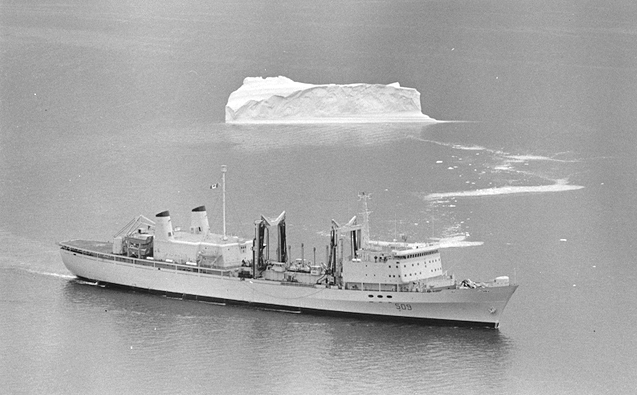
Gulf War Configuration
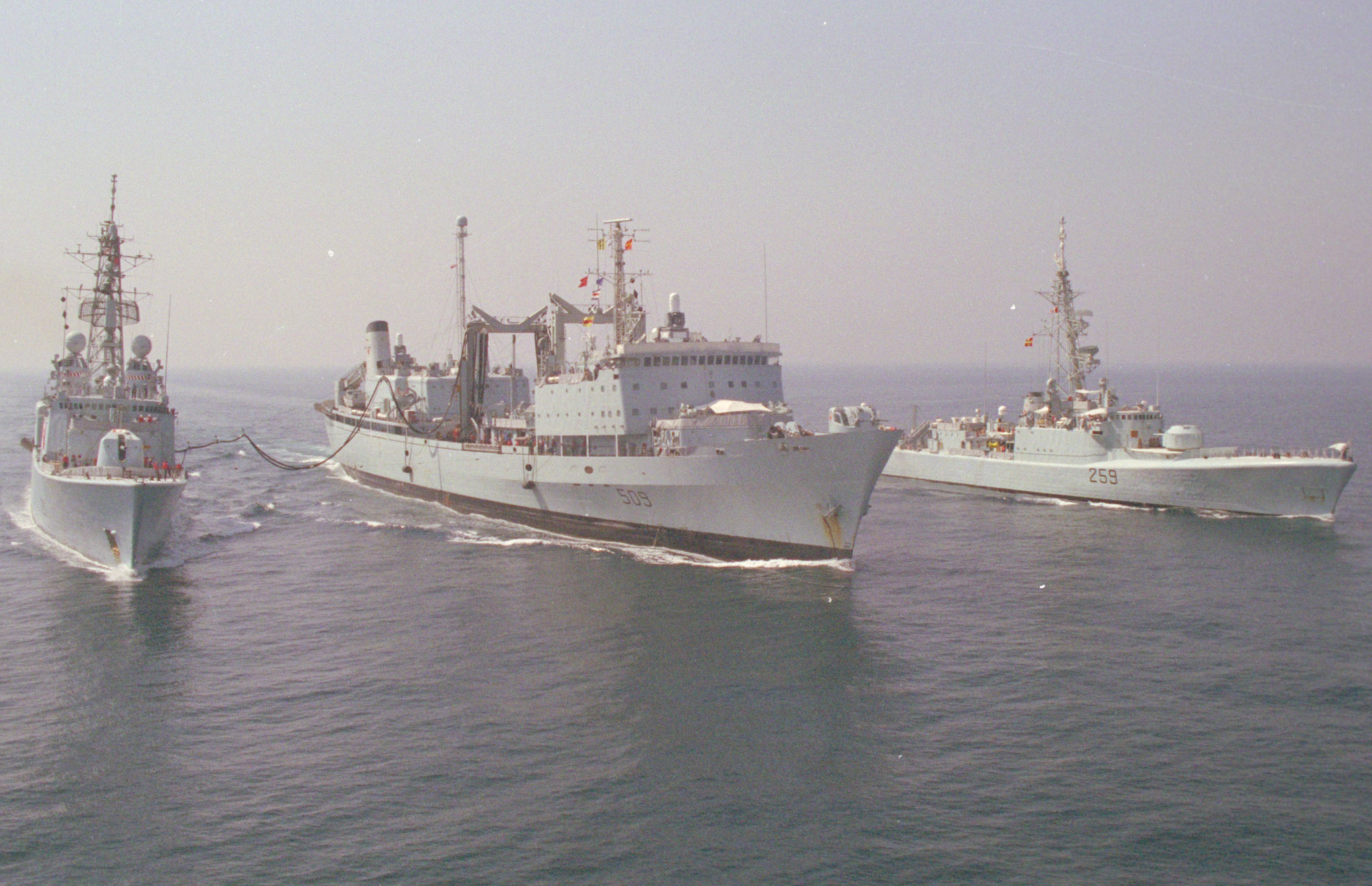
Post Gulf War Deployment

Overview: HMCS Protecteur is a Canadian "Protecteur"-class Auxiliary Oiler Replenishment (replenishment oiler) ship. Built by Saint John Shipbuilding and Dry Docks in Saint John, New Brunswick, she was commissioned in 1969, the first ship of her class.
Details: Protecteur class ships are deployed to supply fuel, food and ammunitions to Canadian and allied warships at sea. The vessel’s displacement is five times greater than that of a frigate. This allows it to supply provisions to a group of six destroyers for six weeks without returning to port for resupply. The ships are also equipped with modern medical equipment making them ideal for disaster response and support duties.
Specifications:
Displacement: 24,000tonnes fully loaded
Dimensions: Length 171.9m, beam 23.2, draught 10.1m
Propulsion: 2 × Babcock & Wilcox boilers, 1 × General Electric steam turbine engine at 21,000 shp (16,000 kW)
Crew: 365 officers and crew, including 45 in air detachment
Aviation: aft helicopter deck with hangar; up to 3 CH-124 Sea King helicopters
Cargo: 14,590 t (14,360 long tons) of fuel, 400 t (394 long tons) of aviation fuel, 1,048 t (1,031 long tons) of dry cargo, and 1,250 t (1,230 long tons) of ammunition, spares
Armament: 1 x FMC 3”/50 (later removed), 1 Mk.29 octuple Sea Sparrow (fitted for but not with), 6 × .50 calibre machine guns
NOTES: The Canadian Navy never purchased any Mk.29 Sea Sparrow launchers for these ships but the design originally allowed for them.
Sources:
http://www.hazegray.org/navhist/canada/current/protect/
https://en.wikipedia.org/wiki/Protecteu ... ment_oiler
https://readyayeready.com/ships/shipvie ... PROTECTEUR
https://www.naval-technology.com/projec ... eur-class/
#722 AOR 509 Protecteur, 1990, (Gulf War)
Overview: HMCS Protecteur is a Canadian "Protecteur"-class Auxiliary Oiler Replenishment (replenishment oiler) ship. Built by Saint John Shipbuilding and Dry Docks in Saint John, New Brunswick, she was commissioned in 1969, the first ship of her class.
Details: Protecteur departed Halifax on 24 August 1990 for Operation Friction with her bow 3-inch/50 re-installed, as well as two CIWS mounts (permanent post conflict), two Bofors 40mm guns, six 0.5 inch (12.7mm) machine guns as well as Blowpipe and Javelin MAPADS during the Gulf War deployment. Countermeasures & decoys added for the mission included 4 × BAE Systems Mark 36 SRBOC chaff launchers and the AN/SLQ-25 Nixie towed decoy. The Protecteur class ships are deployed to supply fuel, food and ammunitions to Canadian and allied warships at sea. The vessel’s displacement is five times greater than that of a frigate. This allows it to supply provisions to a group of six destroyers for six weeks without returning to port for resupply. The ships are also equipped with modern medical equipment making them ideal for disaster response and support duties.
Specifications:
Displacement: 24,000tonnes fully loaded
Dimensions: Length 171.9m, beam 23.2, draught 10.1m
Propulsion: 2 × Babcock & Wilcox boilers, 1 × General Electric steam turbine engine at 21,000 shp (16,000 kW)
Crew: 365 officers and crew, including 45 in air detachment
Aviation: aft helicopter deck with hangar; up to 3 CH-124 Sea King helicopters
Cargo: 14,590 t (14,360 long tons) of fuel, 400 t (394 long tons) of aviation fuel, 1,048 t (1,031 long tons) of dry cargo, and 1,250 t (1,230 long tons) of ammunition, spares
NOTES:
Sources:
http://www.hazegray.org/navhist/canada/current/protect/
https://en.wikipedia.org/wiki/Protecteu ... ment_oiler
https://readyayeready.com/ships/shipvie ... PROTECTEUR
https://www.naval-technology.com/projec ... eur-class/
#2677 AOR 509 Protecteur, 2000-14
Overview:[/b] HMCS Protecteur is a Canadian "Protecteur"-class Auxiliary Oiler Replenishment (replenishment oiler) ship. Built by Saint John Shipbuilding and Dry Docks in Saint John, New Brunswick, she was commissioned in 1969, the first ship of her class.
Details: Protecteur class ships are deployed to supply fuel, food and ammunitions to Canadian and allied warships at sea. The vessel’s displacement is five times greater than that of a frigate. This allows it to supply provisions to a group of six destroyers for six weeks without returning to port for resupply. The ships are also equipped with modern medical equipment making them ideal for disaster response and support duties.
Specifications:
Displacement: 24,000tonnes fully loaded
Dimensions: Length 171.9m, beam 23.2, draught 10.1m
Propulsion: 2 × Babcock & Wilcox boilers, 1 × General Electric steam turbine engine at 21,000 shp (16,000 kW)
Crew: 365 officers and crew, including 45 in air detachment
Aviation: aft helicopter deck with hangar; up to 3 CH-124 Sea King helicopters
Cargo: 14,590 t (14,360 long tons) of fuel, 400 t (394 long tons) of aviation fuel, 1,048 t (1,031 long tons) of dry cargo, and 1,250 t (1,230 long tons) of ammunition, spares
Armament: 1 x FMC 3”/50 (later removed), 1 Mk.29 octuple Sea Sparrow (fitted for but not with), 6 × .50 calibre machine guns
Countermeasures & decoys: 4 × BAE Systems Mark 36 SRBOC chaff launchers and the AN/SLQ-25 Nixie towed decoy
NOTES:
Sources:
http://www.hazegray.org/navhist/canada/current/protect/
https://en.wikipedia.org/wiki/Protecteu ... ment_oiler
https://readyayeready.com/ships/shipvie ... PROTECTEUR
https://www.naval-technology.com/projec ... eur-class/
Original Configuration

Gulf War Configuration

Post Gulf War Deployment


RE: IDEA/PROPOSAL: Community creation/review of unit description
#2392 & #2393 CCGS Cape Roger (Coast Guard)
Overview: CCGS Cape Roger is the lead ship of its class operated by the Canadian Coast Guard.
Details: Named for a cape on the western side of Placentia Bay on the island of Newfoundland, the ship was commissioned into the Canadian Coast Guard in August 1977. Cape Roger is homeported at CCG Base St. John's in St. John's, Newfoundland. The ship is used to monitor the Atlantic Canada fisheries, primarily those on the Grand Banks of Newfoundland, as well as scientific missions and SAR operations. In 2011 the helicopter hanger was removed and replaced with a workshop, the flight deck was modified and permanent railings were added as such the deck can now only be used for helo hoisting.
Specifications:
Displacement: 1,465 long tons (1,489 t) full load
Length 62.5 m (205 ft 1 in), beam 12.1 m (39 ft 8 in), draught 5.3 m (17 ft 5 in)
Notes: During the Turbot War, Cape Roger took part in the detainment of the Spanish fishing trawler Estai.
Sources:
https://inter-j01.dfo-mpo.gc.ca/fdat/vessels/44
https://en.wikipedia.org/wiki/CCGS_Cape_Roger
Overview: CCGS Cape Roger is the lead ship of its class operated by the Canadian Coast Guard.
Details: Named for a cape on the western side of Placentia Bay on the island of Newfoundland, the ship was commissioned into the Canadian Coast Guard in August 1977. Cape Roger is homeported at CCG Base St. John's in St. John's, Newfoundland. The ship is used to monitor the Atlantic Canada fisheries, primarily those on the Grand Banks of Newfoundland, as well as scientific missions and SAR operations. In 2011 the helicopter hanger was removed and replaced with a workshop, the flight deck was modified and permanent railings were added as such the deck can now only be used for helo hoisting.
Specifications:
Displacement: 1,465 long tons (1,489 t) full load
Length 62.5 m (205 ft 1 in), beam 12.1 m (39 ft 8 in), draught 5.3 m (17 ft 5 in)
Notes: During the Turbot War, Cape Roger took part in the detainment of the Spanish fishing trawler Estai.
Sources:
https://inter-j01.dfo-mpo.gc.ca/fdat/vessels/44
https://en.wikipedia.org/wiki/CCGS_Cape_Roger

RE: IDEA/PROPOSAL: Community creation/review of unit description
#1327 DDE Restigouche, 1970 Improved
Overview: The Restigouche-class destroyer was a class of seven destroyer escorts that served the Royal Canadian Navy from the late-1950s to the late-1990s. All seven vessels in the class were named after rivers in Canada.
Details: Due to delays in design and construction of the St. Laurent class the number of vessels was halved to seven. The seven remaining vessels were redesigned as the Restigouche class taking into account design improvements found with the St. Laurents. The seven ships of the class were commissioned between 1958 and 1959.
Five ships of this class were later refitted to what is known as the Improved RESTIGOUCHE (IRE) class, which replaced the aft 3"/50 gun with an octuple ASROC launcher and the old mast with a new, taller lattice mast. The stern was also altered in order to accommodate a new VDS.
Specifications:
Displacement: 2,900t after IRE
Length: 111.6m
Beam: 12.8m
Draught: 4.3m
Propulsion: 2 × English-Electric (John Inglis and Company) geared steam turbines
2 × Babcock & Wilcox boilers
Complement: 214 after IRE/DELEX
Speed: 28kts
Range: 8,800km at 14kts
Notes: In August of 1990, TERRA NOVA was hastily (and temporarily) re-equipped and deployed as part of Canada's contribution to Coalition forces during the Gulf War. RESTIGOUCHE was similarly refitted for service in the Persian Gulf, but did not deploy until after the end of hostilities. After being paid off, TERRA NOVA appeared in the movie "K-19 - The Widowmaker" starring as a USN destroyer.
Sources
https://www.hazegray.org/navhist/canada ... /restigou/
https://www.seaforces.org/marint/Canadi ... -class.htm
https://readyayeready.com/ships/shipvie ... HE%20(2nd)
https://en.wikipedia.org/wiki/Restigouc ... _destroyer
#1464 DDE Restigouche, 1983 DELEX, #871 DDE Restigouche, 1984 DELEX, #2679 DDE Restigouche, 1990 DELEX, #2237 DDE Restigouche, 1993-97 DELEX
Overview: The Restigouche-class destroyer was a class of seven destroyer escorts that served the Royal Canadian Navy from the late-1950s to the late-1990s. All seven vessels in the class were named after rivers in Canada.
Details: The Destroyer Life Extension (DELEX) refit for four surviving Restigouches was announced in 1978. For the Restigouches this meant updating their sensor, weapon and communications systems. The class received the new ADLIPS tactical data system, new radar and fire control systems and satellite navigation. The 103 mm (4 in) Bofors illumination rocket system was removed, replaced by a Super RBOC chaff system. The class were also fitted with two triple 533-millimetre (21 in) Mk 32 torpedo tube mountings to use the new Mk 46 torpedo. The ships began undergoing their DELEX refits in the early 1980s.
Specifications:
Displacement: 2,900t after IRE
Length: 111.6m
Beam: 12.8m
Draught: 4.3m
Propulsion: 2 × English-Electric (John Inglis and Company) geared steam turbines
2 × Babcock & Wilcox boilers
Complement: 214 after IRE/DELEX
Speed: 28kts
Range: 8,800km at 14kts
Notes: After being paid off, TERRA NOVA appeared in the movie "K-19 - The Widowmaker" starring as a USN destroyer.
#1380 DDE Restigouche, 1991 Gulf War
Overview: The Restigouche-class destroyer was a class of seven destroyer escorts that served the Royal Canadian Navy from the late-1950s to the late-1990s. All seven vessels in the class were named after rivers in Canada.
Details: Maritime Command chose Terra Nova to deploy with the task force (Athabaskan, Protecteur) to the Persian Gulf from among the fleet as she had the best electronic countermeasures suite due to recent upgrades. The ship's ASROC system was landed and instead two quad Harpoon surface-to-surface missile systems were installed. A Mk 15 Phalanx close-in weapon system was placed on the quarterdeck in place of the landed Limbo ASW mortar, and two 40 mm/60 calibre Boffin guns were installed in single mounts where the ship's boats were and shoulder-fired Blowpipe and Javelin missiles were also added. The ship was also fitted with new chaff, electronic and communications systems. Restigouche received a similar refit before deploying as Terra Nova's intended replacement in the Persian Gulf in 1991
Specifications:
Displacement: 2,900t after IRE
Length: 111.6m
Beam: 12.8m
Draught: 4.3m
Propulsion: 2 × English-Electric (John Inglis and Company) geared steam turbines
2 × Babcock & Wilcox boilers
Complement: 214 after IRE/DELEX
Speed: 28kts
Range: 8,800km at 14kts
Notes: Terra Nova and the other two ships were made ready for deployment in only ten days using many systems in storage for the building Halifax class. RESTIGOUCHE did not deploy until after the end of hostilities.
Sources:
https://en.wikipedia.org/wiki/HMCS_Terra_Nova
https://www.canada.ca/en/navy/services/ ... -nova.html
http://www.forposterityssake.ca/Navy/HM ... VA_259.htm
https://www.hazegray.org/navhist/canada ... /restigou/
https://www.warmuseum.ca/cwm/exhibition ... ge=15.html
IRE Configuration

DELEX Configuration
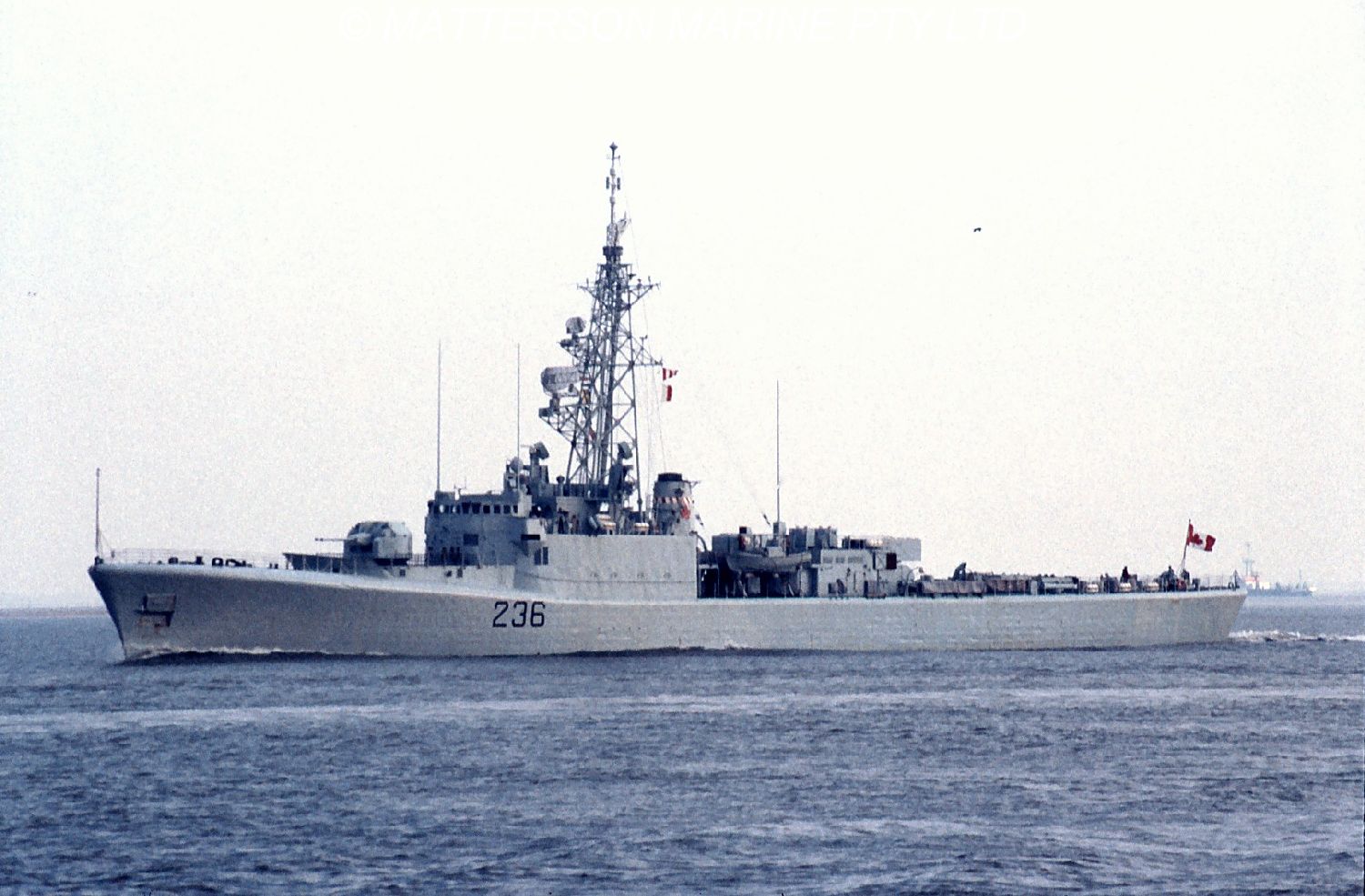
Gulf War Configuration

Overview: The Restigouche-class destroyer was a class of seven destroyer escorts that served the Royal Canadian Navy from the late-1950s to the late-1990s. All seven vessels in the class were named after rivers in Canada.
Details: Due to delays in design and construction of the St. Laurent class the number of vessels was halved to seven. The seven remaining vessels were redesigned as the Restigouche class taking into account design improvements found with the St. Laurents. The seven ships of the class were commissioned between 1958 and 1959.
Five ships of this class were later refitted to what is known as the Improved RESTIGOUCHE (IRE) class, which replaced the aft 3"/50 gun with an octuple ASROC launcher and the old mast with a new, taller lattice mast. The stern was also altered in order to accommodate a new VDS.
Specifications:
Displacement: 2,900t after IRE
Length: 111.6m
Beam: 12.8m
Draught: 4.3m
Propulsion: 2 × English-Electric (John Inglis and Company) geared steam turbines
2 × Babcock & Wilcox boilers
Complement: 214 after IRE/DELEX
Speed: 28kts
Range: 8,800km at 14kts
Notes: In August of 1990, TERRA NOVA was hastily (and temporarily) re-equipped and deployed as part of Canada's contribution to Coalition forces during the Gulf War. RESTIGOUCHE was similarly refitted for service in the Persian Gulf, but did not deploy until after the end of hostilities. After being paid off, TERRA NOVA appeared in the movie "K-19 - The Widowmaker" starring as a USN destroyer.
Sources
https://www.hazegray.org/navhist/canada ... /restigou/
https://www.seaforces.org/marint/Canadi ... -class.htm
https://readyayeready.com/ships/shipvie ... HE%20(2nd)
https://en.wikipedia.org/wiki/Restigouc ... _destroyer
#1464 DDE Restigouche, 1983 DELEX, #871 DDE Restigouche, 1984 DELEX, #2679 DDE Restigouche, 1990 DELEX, #2237 DDE Restigouche, 1993-97 DELEX
Overview: The Restigouche-class destroyer was a class of seven destroyer escorts that served the Royal Canadian Navy from the late-1950s to the late-1990s. All seven vessels in the class were named after rivers in Canada.
Details: The Destroyer Life Extension (DELEX) refit for four surviving Restigouches was announced in 1978. For the Restigouches this meant updating their sensor, weapon and communications systems. The class received the new ADLIPS tactical data system, new radar and fire control systems and satellite navigation. The 103 mm (4 in) Bofors illumination rocket system was removed, replaced by a Super RBOC chaff system. The class were also fitted with two triple 533-millimetre (21 in) Mk 32 torpedo tube mountings to use the new Mk 46 torpedo. The ships began undergoing their DELEX refits in the early 1980s.
Specifications:
Displacement: 2,900t after IRE
Length: 111.6m
Beam: 12.8m
Draught: 4.3m
Propulsion: 2 × English-Electric (John Inglis and Company) geared steam turbines
2 × Babcock & Wilcox boilers
Complement: 214 after IRE/DELEX
Speed: 28kts
Range: 8,800km at 14kts
Notes: After being paid off, TERRA NOVA appeared in the movie "K-19 - The Widowmaker" starring as a USN destroyer.
#1380 DDE Restigouche, 1991 Gulf War
Overview: The Restigouche-class destroyer was a class of seven destroyer escorts that served the Royal Canadian Navy from the late-1950s to the late-1990s. All seven vessels in the class were named after rivers in Canada.
Details: Maritime Command chose Terra Nova to deploy with the task force (Athabaskan, Protecteur) to the Persian Gulf from among the fleet as she had the best electronic countermeasures suite due to recent upgrades. The ship's ASROC system was landed and instead two quad Harpoon surface-to-surface missile systems were installed. A Mk 15 Phalanx close-in weapon system was placed on the quarterdeck in place of the landed Limbo ASW mortar, and two 40 mm/60 calibre Boffin guns were installed in single mounts where the ship's boats were and shoulder-fired Blowpipe and Javelin missiles were also added. The ship was also fitted with new chaff, electronic and communications systems. Restigouche received a similar refit before deploying as Terra Nova's intended replacement in the Persian Gulf in 1991
Specifications:
Displacement: 2,900t after IRE
Length: 111.6m
Beam: 12.8m
Draught: 4.3m
Propulsion: 2 × English-Electric (John Inglis and Company) geared steam turbines
2 × Babcock & Wilcox boilers
Complement: 214 after IRE/DELEX
Speed: 28kts
Range: 8,800km at 14kts
Notes: Terra Nova and the other two ships were made ready for deployment in only ten days using many systems in storage for the building Halifax class. RESTIGOUCHE did not deploy until after the end of hostilities.
Sources:
https://en.wikipedia.org/wiki/HMCS_Terra_Nova
https://www.canada.ca/en/navy/services/ ... -nova.html
http://www.forposterityssake.ca/Navy/HM ... VA_259.htm
https://www.hazegray.org/navhist/canada ... /restigou/
https://www.warmuseum.ca/cwm/exhibition ... ge=15.html
IRE Configuration

DELEX Configuration

Gulf War Configuration


RE: IDEA/PROPOSAL: Community creation/review of unit description
ORIGINAL: CV60
quote:
ORIGINAL: CV60
Draft MiG-23BN Flogger H for comment by the community. There isn't too much to write about regarding the Flogger H. If anyone has any interesting "factoids" that might be interesting to the player, please let me know, and I'll add it.
...
Although not implemented in the game now the SPS-141 ECM covers only frontal aspect of MiG-23BN due to antennas installation in front of the aircraft. May be this information could be added here.
Thanks. I will add that. (That is one of the good things about the description files-We can put things here that are true, but are not yet implemented in the game). If you have a source for that infor, I will add it to the "Sources" file
Unfortunately I don't have english sources for this information. But it is mentioned in this german article here:
http://www.jbg37.de/html/storsender_sps_141-142.htm
Translation of particular paragraph is:
"In the air force of the NVA there are different modifications of the jamming devices SPS 141/142, on the one hand for installation in aircraft with the radiation to the front, on the other hand - housed in special jamming containers - for suspension under the fuselage (radiation to the front) or under the Wings with radiation to the front or rear (choice by the pilot)."
RE: IDEA/PROPOSAL: Community creation/review of unit description
OVERVIEW: The Amsterdam is a Fast Combat Support Ship for oil and goods replanishment at sea.
DETAILS: HNLMS Amsterdam has two MAN/Bazan diesels with 2400 hp and 1 shaft.
Cargo capacity is 6700 tons F76 diesel, 1660 tons F44 aviation fuel and 290 tons solid cargo. 178.8 tons fresh water which also can be replensihed to other units
She has 2 oil replenishment positions on both sides and one one stern to be able to supply three ships at the same time. One Vertrep supply station.
Her hangar can hold 3 lynx or 3 Seaking or 2 EH101 Merlins. One helicopter spot.
The 44 extra crew can be for aviation, boarding teams, medical, marines depending her mission.
Weapon and sensor fot for self-protectection with SS & navigation radars and ESM. Weapons are CIWS, decoys for ASM and torpedo's also 12.7mm calibre MG's.
SPECIFICATIONS:
Displacement: 17313 ton (full)
Speed: 21 kts (max)
Engineering: 2x MAN/Bazan, 2400 hp
Range: 13440 nm @ 20 kts
Endurance: ?
Complement: crew 136 with 44 extra
NOTES: Decommissioned in September 2014 and transferred to the Peruvian Navy as BAP Tacna
SOURCES:"Amsterdam supply ship." Marineschepen. Last Modified: 15-02-2018. https://marineschepen.nl/schepen/amsterdam.html;
"HNLMS Amsterdam AOR." GlobalSecurity. Last Modified: 05-06-2016. https://www.globalsecurity.org/military ... ms-aor.htm
"HNLMS Amsterdam (A836)." Wikipedia. Last Modified: 13-08-2021. https://en.wikipedia.org/wiki/HNLMS_Amsterdam_(A836)
DETAILS: HNLMS Amsterdam has two MAN/Bazan diesels with 2400 hp and 1 shaft.
Cargo capacity is 6700 tons F76 diesel, 1660 tons F44 aviation fuel and 290 tons solid cargo. 178.8 tons fresh water which also can be replensihed to other units
She has 2 oil replenishment positions on both sides and one one stern to be able to supply three ships at the same time. One Vertrep supply station.
Her hangar can hold 3 lynx or 3 Seaking or 2 EH101 Merlins. One helicopter spot.
The 44 extra crew can be for aviation, boarding teams, medical, marines depending her mission.
Weapon and sensor fot for self-protectection with SS & navigation radars and ESM. Weapons are CIWS, decoys for ASM and torpedo's also 12.7mm calibre MG's.
SPECIFICATIONS:
Displacement: 17313 ton (full)
Speed: 21 kts (max)
Engineering: 2x MAN/Bazan, 2400 hp
Range: 13440 nm @ 20 kts
Endurance: ?
Complement: crew 136 with 44 extra
NOTES: Decommissioned in September 2014 and transferred to the Peruvian Navy as BAP Tacna
SOURCES:"Amsterdam supply ship." Marineschepen. Last Modified: 15-02-2018. https://marineschepen.nl/schepen/amsterdam.html;
"HNLMS Amsterdam AOR." GlobalSecurity. Last Modified: 05-06-2016. https://www.globalsecurity.org/military ... ms-aor.htm
"HNLMS Amsterdam (A836)." Wikipedia. Last Modified: 13-08-2021. https://en.wikipedia.org/wiki/HNLMS_Amsterdam_(A836)
RE: IDEA/PROPOSAL: Community creation/review of unit description
Here is a draft for the S.266 radar. Not too much information on this system, so any community input would be welcome.
OVERVIEW: The Marconi S.266 is a fixed, 2D, Long-Range Air Search radar operating in the NATO "D" and "F" bands.
DETAILS: The S.266 is a long-range radar system using two radars in a back-to-back configuration. Because it could not get height information, the a height finding radar such as the S.244 was usually associated with the system.
Specifications:
Frequency 1.3 and 3.0 GHz (D and F band (NATO), L and S Band (IEEE))
Power output: 2.25 MW
PRF: ?? pps
Range Resolution: unknown
On/Off time: unknown min.
Deploy/Stow time: N/A min
Maximum Range: km (range), km (altitude)
NOTES: Used in NATO NADGE radar network.
SOURCES: "Marconi Radar History / Major Achievements of Marconi Radar." Marconi Radar History / MARCONI RADAR. Accessed October 5, 2021. https://marconiradarhistory.pbworks.com ... ni%20Radar. ; Radar Pages. Accessed October 5, 2021. https://www.radarpages.co.uk/download/radar_g97.doc.
OVERVIEW: The Marconi S.266 is a fixed, 2D, Long-Range Air Search radar operating in the NATO "D" and "F" bands.
DETAILS: The S.266 is a long-range radar system using two radars in a back-to-back configuration. Because it could not get height information, the a height finding radar such as the S.244 was usually associated with the system.
Specifications:
Frequency 1.3 and 3.0 GHz (D and F band (NATO), L and S Band (IEEE))
Power output: 2.25 MW
PRF: ?? pps
Range Resolution: unknown
On/Off time: unknown min.
Deploy/Stow time: N/A min
Maximum Range: km (range), km (altitude)
NOTES: Used in NATO NADGE radar network.
SOURCES: "Marconi Radar History / Major Achievements of Marconi Radar." Marconi Radar History / MARCONI RADAR. Accessed October 5, 2021. https://marconiradarhistory.pbworks.com ... ni%20Radar. ; Radar Pages. Accessed October 5, 2021. https://www.radarpages.co.uk/download/radar_g97.doc.
“Do I not destroy my enemies when I make them my friends?” -Abraham Lincoln
RE: IDEA/PROPOSAL: Community creation/review of unit description
#870 DDE Mackenzie, 1972
Overview: Delivered in the early 1960s, the Mackenzie class was similar to the previous Restigouche-class, a follow-on to the St. Laurent-class. The most noticeable changes were the replacement of the forward 3"/50 gun with a 3"/70(except Qu'Appelle), the presence of a fire-control director atop the bridge superstructure which was raised one full deck higher than on previous classes in order to see over the new gun mount.
Details: Originally to be a class of 6 improved, more capable and larger ships than the St. Laurents budget issues cut the order from six to four ships and forced a repeat of the Restigouche class. Two mountings held guns to engage aircraft or surface targets. Much of the after deck was taken up with retractable covers for the ship's Limbo anti-submarine mortars.
Specifications:
Displacement: 2,380 t
Length: 113.1m
Beam: 12.8m
Draught: 4.1m
Propulsion: 2 shafts, 2 × English-Electric geared steam turbines
Complement: 228
Speed: 28kn
Range: 4,750km @ 14kn
Notes: The four Mackenzie-class destroyers spent most of their service in the Pacific Ocean, used primarily in a training role. The last two hulls of the original planned six became the Annapolis class.
Sources:
https://en.wikipedia.org/wiki/Mackenzie-class_destroyer
https://www.seaforces.org/marint/Canadian-Navy/Destroyer/Mackenzie-class.htm
http://www.hazegray.org/navhist/canada/postwar/mackenzi/
https://readyayeready.com/ships/shipview.php?id=1237
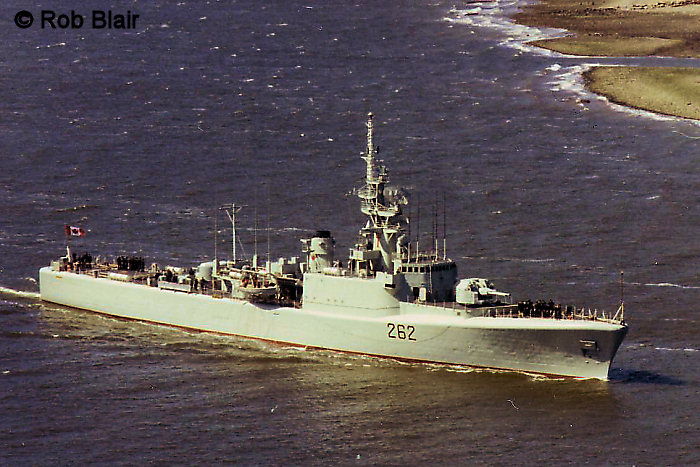
#1326 DDE Mackenzie, 1984 DELEX, #2238 DDE Mackenzie, 1991-93 DELEX
Overview: Delivered in the early 1960s, the Mackenzie class was similar to the previous Restigouche-class, a follow-on to the St. Laurent-class. The most noticeable changes for Mackenzie was the replacement of the forward 3"/50 gun with a 3"/70(except Qu'Appelle), the presence of a fire-control director atop the bridge superstructure which was raised one full deck higher than on previous classes in order to see over the new gun mount.
Details: The DELEX refit for the Mackenzie class was the same for the Improved Restigouche-class vessels. This meant that the ships would receive the new tactical data system ADLIPS, new radars, new fire control and satellite navigation.They exchanged the SQS-503 sonar for the newer SQS-505 model.The sonar dome was installed on the hull and there were further modifications to the SPS-12 air search radar. They also received two triple mounts for 12.75-inch (324 mm) torpedo tubes that would use the new Mk 46 homing torpedo. The tubes were sited on the quarterdeck.
Specifications:
Displacement: 2,380 t
Length: 113.1m
Beam: 12.8m
Draught: 4.1m
Propulsion: 2 shafts, 2 × English-Electric geared steam turbines
Complement: 228
Speed: 28kn
Range: 4,750km @ 14kn
Notes: The four Mackenzie-class destroyers spent most of their service in the Pacific Ocean, used primarily in a training role. Their only significant update was the DELEX (destroyer life extension) program, which was completed between 1982 and 1985 and updated their navigational radar and their sonar.
Sources:
https://en.wikipedia.org/wiki/Mackenzie-class_destroyer
https://www.seaforces.org/marint/Canadian-Navy/Destroyer/Mackenzie-class.htm
http://www.hazegray.org/navhist/canada/postwar/mackenzi/
https://readyayeready.com/ships/shipview.php?id=1237

Overview: Delivered in the early 1960s, the Mackenzie class was similar to the previous Restigouche-class, a follow-on to the St. Laurent-class. The most noticeable changes were the replacement of the forward 3"/50 gun with a 3"/70(except Qu'Appelle), the presence of a fire-control director atop the bridge superstructure which was raised one full deck higher than on previous classes in order to see over the new gun mount.
Details: Originally to be a class of 6 improved, more capable and larger ships than the St. Laurents budget issues cut the order from six to four ships and forced a repeat of the Restigouche class. Two mountings held guns to engage aircraft or surface targets. Much of the after deck was taken up with retractable covers for the ship's Limbo anti-submarine mortars.
Specifications:
Displacement: 2,380 t
Length: 113.1m
Beam: 12.8m
Draught: 4.1m
Propulsion: 2 shafts, 2 × English-Electric geared steam turbines
Complement: 228
Speed: 28kn
Range: 4,750km @ 14kn
Notes: The four Mackenzie-class destroyers spent most of their service in the Pacific Ocean, used primarily in a training role. The last two hulls of the original planned six became the Annapolis class.
Sources:
https://en.wikipedia.org/wiki/Mackenzie-class_destroyer
https://www.seaforces.org/marint/Canadian-Navy/Destroyer/Mackenzie-class.htm
http://www.hazegray.org/navhist/canada/postwar/mackenzi/
https://readyayeready.com/ships/shipview.php?id=1237

#1326 DDE Mackenzie, 1984 DELEX, #2238 DDE Mackenzie, 1991-93 DELEX
Overview: Delivered in the early 1960s, the Mackenzie class was similar to the previous Restigouche-class, a follow-on to the St. Laurent-class. The most noticeable changes for Mackenzie was the replacement of the forward 3"/50 gun with a 3"/70(except Qu'Appelle), the presence of a fire-control director atop the bridge superstructure which was raised one full deck higher than on previous classes in order to see over the new gun mount.
Details: The DELEX refit for the Mackenzie class was the same for the Improved Restigouche-class vessels. This meant that the ships would receive the new tactical data system ADLIPS, new radars, new fire control and satellite navigation.They exchanged the SQS-503 sonar for the newer SQS-505 model.The sonar dome was installed on the hull and there were further modifications to the SPS-12 air search radar. They also received two triple mounts for 12.75-inch (324 mm) torpedo tubes that would use the new Mk 46 homing torpedo. The tubes were sited on the quarterdeck.
Specifications:
Displacement: 2,380 t
Length: 113.1m
Beam: 12.8m
Draught: 4.1m
Propulsion: 2 shafts, 2 × English-Electric geared steam turbines
Complement: 228
Speed: 28kn
Range: 4,750km @ 14kn
Notes: The four Mackenzie-class destroyers spent most of their service in the Pacific Ocean, used primarily in a training role. Their only significant update was the DELEX (destroyer life extension) program, which was completed between 1982 and 1985 and updated their navigational radar and their sonar.
Sources:
https://en.wikipedia.org/wiki/Mackenzie-class_destroyer
https://www.seaforces.org/marint/Canadian-Navy/Destroyer/Mackenzie-class.htm
http://www.hazegray.org/navhist/canada/postwar/mackenzi/
https://readyayeready.com/ships/shipview.php?id=1237


RE: IDEA/PROPOSAL: Community creation/review of unit description
#2236 DDE St. Laurent, 1972
Overview: These ships were the first major warships designed and built in Canada and were some of the very first new designs to appear after the Second World War, and among the most sophisticated. Known as 'Cadillacs', they had relatively luxurious crew accomodations. They were similar to the RN's contemporary WHITBY (Type 12) frigates, but relied more on American equipment than British.
Details: Designed to operate in harsh Canadian conditions, these ships looked remarkably different from other warships of the time. In the early 1960's all seven ships of this class were converted into helicopter carrying destroyers (DDH). This involved the removal of one of the Limbo ASW mortars and the aft 3"/50 gun to make room for the hangar and landing deck, the twinning of the single funnel, and various other improvements all over the ship. Activated fin stabilizers were added to reduce the ship's roll in heavy seas, as well as the Beartrap device which allows helicopter recovery in almost any sea state. One CH 124 Sea King helicopter was carried. The transom was altered drastically in order to allow for the placement of the new Canadian designed SQS 504 VDS. The VDS was instrumental in extending the range of the ship's sonar, then limited to about 2000 yards.
Specifications:
Displacement: 2,800t
Length: 111.56 m
Beam: 12.8m
Draught: 3.96m
Propulsion: 2 shafts; 2 Babcock & Wilcox water tube boilers; 2 English Electric geared turbines, 30,000 shp
Complement: 249
Speed: 28kn
Range: 8,463.6km @ 12kn
Notes: The ST. LAURENT class served as the basis for another 11 ships, in two different classes, whose design differed only slightly. All were named after Canadian rivers, though many shared names with Second World War destroyers.
Sources:
https://www.seaforces.org/marint/Canadian-Navy/Destroyer/St-Laurent-class.htm
https://en.wikipedia.org/wiki/St._Laurent-class_destroyer
http://www.hazegray.org/navhist/canada/postwar/stlauren/
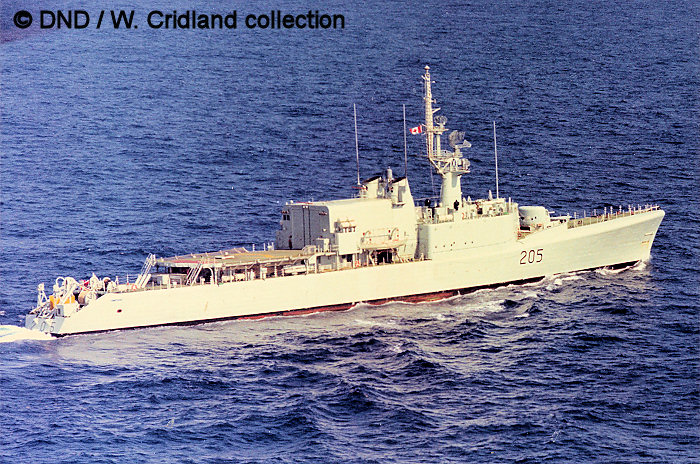
#1334 DDE St. Laurent, 1981 DELEX, #872 DDE St. Laurent, 1984-94 DELEX
Overview: These ships were the first major warships designed and built in Canada and were some of the very first new designs to appear after the Second World War, and among the most sophisticated. Known as 'Cadillacs', they had relatively luxurious crew accomodations. They were similar to the RN's contemporary WHITBY (Type 12) frigates, but relied more on American equipment than British.
Details: The Destroyer Life Extension (DELEX) program was commissioned to upgrade the St. Laurent-class ships with new electronics, machinery, and hull upgrades and repairs. The intent of DELEX was to extend the life of these ships for another 15 years of service while the Halifax-class frigates were being designed and built as part of the Canadian Patrol Frigate Program. DELEX included the installation of a Naval Tactical Data System (NTDS) known as the Automatic Data Link Plotting System (ADLIPS), Canadian Electronic Warfare System (CANEWS), and a new communication suite as well hull and machinery repairs.
Specifications:
Displacement: 3,051
Length: 111.56 m
Beam: 12.8m
Draught: 3.96m
Propulsion: 2 shafts; 2 Babcock & Wilcox water tube boilers; 2 English Electric geared turbines, 30,000 shp
Complement: 233
Speed: 28kn
Range: 8,463.6km @ 12kn
Notes: After completing her DELEX HMCS Fraser was used as a test ship for new equipment including the SQR-19/CANTASS, SLQ 25 Nixie (both ended up on Halifax class), URN-20 TACAN and the HELTAS (Helicopter Towed Array Sonar) system.
Sources:
https://www.seaforces.org/marint/Canadian-Navy/Destroyer/St-Laurent-class.htm
https://en.wikipedia.org/wiki/St._Laurent-class_destroyer
http://www.hazegray.org/navhist/canada/postwar/stlauren/
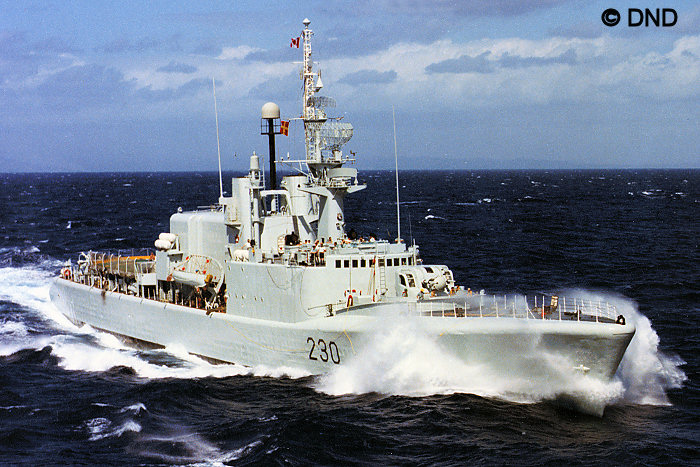
Overview: These ships were the first major warships designed and built in Canada and were some of the very first new designs to appear after the Second World War, and among the most sophisticated. Known as 'Cadillacs', they had relatively luxurious crew accomodations. They were similar to the RN's contemporary WHITBY (Type 12) frigates, but relied more on American equipment than British.
Details: Designed to operate in harsh Canadian conditions, these ships looked remarkably different from other warships of the time. In the early 1960's all seven ships of this class were converted into helicopter carrying destroyers (DDH). This involved the removal of one of the Limbo ASW mortars and the aft 3"/50 gun to make room for the hangar and landing deck, the twinning of the single funnel, and various other improvements all over the ship. Activated fin stabilizers were added to reduce the ship's roll in heavy seas, as well as the Beartrap device which allows helicopter recovery in almost any sea state. One CH 124 Sea King helicopter was carried. The transom was altered drastically in order to allow for the placement of the new Canadian designed SQS 504 VDS. The VDS was instrumental in extending the range of the ship's sonar, then limited to about 2000 yards.
Specifications:
Displacement: 2,800t
Length: 111.56 m
Beam: 12.8m
Draught: 3.96m
Propulsion: 2 shafts; 2 Babcock & Wilcox water tube boilers; 2 English Electric geared turbines, 30,000 shp
Complement: 249
Speed: 28kn
Range: 8,463.6km @ 12kn
Notes: The ST. LAURENT class served as the basis for another 11 ships, in two different classes, whose design differed only slightly. All were named after Canadian rivers, though many shared names with Second World War destroyers.
Sources:
https://www.seaforces.org/marint/Canadian-Navy/Destroyer/St-Laurent-class.htm
https://en.wikipedia.org/wiki/St._Laurent-class_destroyer
http://www.hazegray.org/navhist/canada/postwar/stlauren/

#1334 DDE St. Laurent, 1981 DELEX, #872 DDE St. Laurent, 1984-94 DELEX
Overview: These ships were the first major warships designed and built in Canada and were some of the very first new designs to appear after the Second World War, and among the most sophisticated. Known as 'Cadillacs', they had relatively luxurious crew accomodations. They were similar to the RN's contemporary WHITBY (Type 12) frigates, but relied more on American equipment than British.
Details: The Destroyer Life Extension (DELEX) program was commissioned to upgrade the St. Laurent-class ships with new electronics, machinery, and hull upgrades and repairs. The intent of DELEX was to extend the life of these ships for another 15 years of service while the Halifax-class frigates were being designed and built as part of the Canadian Patrol Frigate Program. DELEX included the installation of a Naval Tactical Data System (NTDS) known as the Automatic Data Link Plotting System (ADLIPS), Canadian Electronic Warfare System (CANEWS), and a new communication suite as well hull and machinery repairs.
Specifications:
Displacement: 3,051
Length: 111.56 m
Beam: 12.8m
Draught: 3.96m
Propulsion: 2 shafts; 2 Babcock & Wilcox water tube boilers; 2 English Electric geared turbines, 30,000 shp
Complement: 233
Speed: 28kn
Range: 8,463.6km @ 12kn
Notes: After completing her DELEX HMCS Fraser was used as a test ship for new equipment including the SQR-19/CANTASS, SLQ 25 Nixie (both ended up on Halifax class), URN-20 TACAN and the HELTAS (Helicopter Towed Array Sonar) system.
Sources:
https://www.seaforces.org/marint/Canadian-Navy/Destroyer/St-Laurent-class.htm
https://en.wikipedia.org/wiki/St._Laurent-class_destroyer
http://www.hazegray.org/navhist/canada/postwar/stlauren/


RE: IDEA/PROPOSAL: Community creation/review of unit description
#1324 DDH Annapolis, 1972
Overview: The Annapolis-class destroyer escort was a two-ship class of destroyer escorts that saw service with the Royal Canadian Navy and Canadian Forces from the 1960s to the 1990s. The final version of the St. Laurent-class design, the class was used extensively for anti-submarine warfare purposes.
Details: The two Annapolis-class destroyers were built late enough to incorporate the helicopter hangar retrofitted to the St. Laurent-class. These ships were among the first to take a new approach to helicopter operations from small warships. Unlike the British, who fitted a small helicopter (Westland Wasp) on their frigates with only a minimum of redesign, the RCN decided to use the far more capable and sophisticated CH-124 Sea King.
Specifications:
Displacement: 3,420t
Length: 111.56 m
Beam: 12.8m
Draught: 4.01m
Propulsion: 2 shafts; 2 Babcock & Wilcox water tube boilers; 2 English Electric geared turbines, 30,000 shp
Complement: 228
Speed: 28kn
Range: 8,463.6km @ 12kn
Notes: The RCN had intended to place a six ship order under the Mackenzie-class of destroyer escorts; however, the last two vessels were built to the St. Laurent-class DDH design and were classed under the new Annapolis-class designation. Both ships spent the majority of their career split between Canada's Pacific and Atlantic coasts with the Annapolis being at Esquimalt and Nipigon at Halifax.
Sources:
https://en.wikipedia.org/wiki/Annapolis-class_destroyer
https://www.seaforces.org/marint/Canadian-Navy/Destroyer/Annapolis-class.htm
http://www.hazegray.org/navhist/canada/postwar/annapoli/
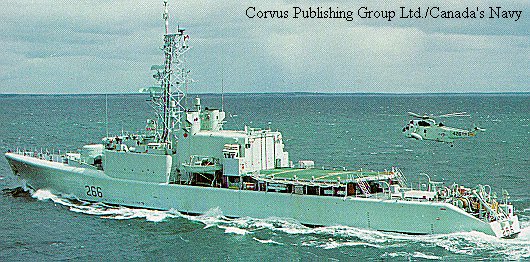
#1325 DDH Annapolis, 1984 DELEX, #2680 DDH Annapolis, 1990 DELEX, #1952 DDH Annapolis, 1993-98 DELEX
Overview: The Annapolis-class destroyer escort was a two-ship class of destroyer escorts that saw service with the Royal Canadian Navy and Canadian Forces from the 1960s to the 1990s. The final version of the St. Laurent-class design, the class was used extensively for anti-submarine warfare purposes.
Details: The Annapolis class received the same sensor and communications upgrades that others in the St Laurent family of ships received, including the installation of a new tactical data system (ADLIPS), updated radars and sonars, fire control and satellite navigation. They also received the new Canadian Tactical Towed Array Sensor or CANTASS which was a long-range towed sonar array that was affixed to the stern, which replaced the older VDS. The class also received a new lattice mast, the AN/SPS-503 radar, and the AN/SPS-10D replaced the older, AN/SPS-10 model. The AN/SQS-502, AN/SQS-503 and SQS-10/11 sonars were removed and replaced by AN/SQS-505(V) in a fixed dome below the waterline. The Limbo mortar was removed in order to install the CANTASS which replaced the AN/SQR-504. In addition a Super RBOC chaff system was installed during the refit and they also received 12.75-inch (324 mm) torpedo tubes to allow them to fire Mark 46 torpedoes.
Specifications:
Displacement: 3,420t
Length: 111.56 m
Beam: 12.8m
Draught: 4.01m
Propulsion: 2 shafts; 2 Babcock & Wilcox water tube boilers; 2 English Electric geared turbines, 30,000 shp
Complement: 210
Speed: 28kn
Range: 8,463.6km @ 12kn
Notes: Nipigon remained in the fleet until 1998 as a trials ship for the ETASS Mod 5 towed sonar system which was a precursor to the CANTASS (Canadian Towed Array Sonar System) that is currently fitted on the Halifax-class of frigates. Nipigon was the last of the steam-powered destroyers to serve in the Canadian Forces.
Sources:
https://en.wikipedia.org/wiki/Annapolis-class_destroyer
https://www.seaforces.org/marint/Canadian-Navy/Destroyer/Annapolis-class.htm
http://www.hazegray.org/navhist/canada/postwar/annapoli/
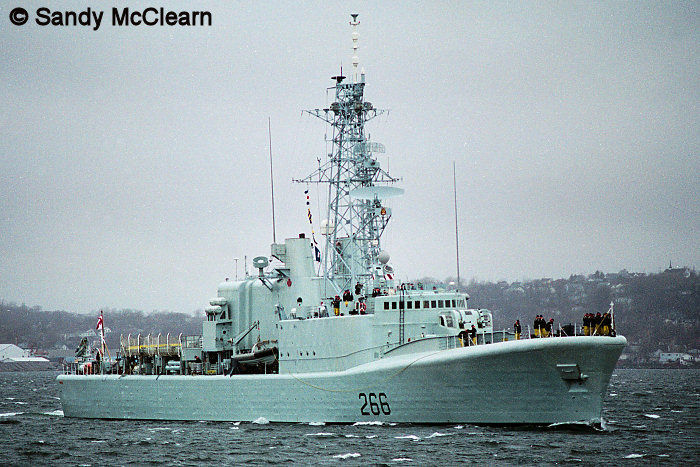
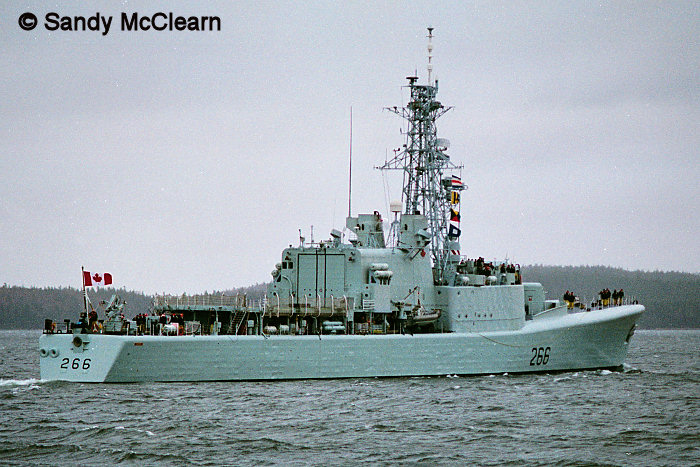
Overview: The Annapolis-class destroyer escort was a two-ship class of destroyer escorts that saw service with the Royal Canadian Navy and Canadian Forces from the 1960s to the 1990s. The final version of the St. Laurent-class design, the class was used extensively for anti-submarine warfare purposes.
Details: The two Annapolis-class destroyers were built late enough to incorporate the helicopter hangar retrofitted to the St. Laurent-class. These ships were among the first to take a new approach to helicopter operations from small warships. Unlike the British, who fitted a small helicopter (Westland Wasp) on their frigates with only a minimum of redesign, the RCN decided to use the far more capable and sophisticated CH-124 Sea King.
Specifications:
Displacement: 3,420t
Length: 111.56 m
Beam: 12.8m
Draught: 4.01m
Propulsion: 2 shafts; 2 Babcock & Wilcox water tube boilers; 2 English Electric geared turbines, 30,000 shp
Complement: 228
Speed: 28kn
Range: 8,463.6km @ 12kn
Notes: The RCN had intended to place a six ship order under the Mackenzie-class of destroyer escorts; however, the last two vessels were built to the St. Laurent-class DDH design and were classed under the new Annapolis-class designation. Both ships spent the majority of their career split between Canada's Pacific and Atlantic coasts with the Annapolis being at Esquimalt and Nipigon at Halifax.
Sources:
https://en.wikipedia.org/wiki/Annapolis-class_destroyer
https://www.seaforces.org/marint/Canadian-Navy/Destroyer/Annapolis-class.htm
http://www.hazegray.org/navhist/canada/postwar/annapoli/

#1325 DDH Annapolis, 1984 DELEX, #2680 DDH Annapolis, 1990 DELEX, #1952 DDH Annapolis, 1993-98 DELEX
Overview: The Annapolis-class destroyer escort was a two-ship class of destroyer escorts that saw service with the Royal Canadian Navy and Canadian Forces from the 1960s to the 1990s. The final version of the St. Laurent-class design, the class was used extensively for anti-submarine warfare purposes.
Details: The Annapolis class received the same sensor and communications upgrades that others in the St Laurent family of ships received, including the installation of a new tactical data system (ADLIPS), updated radars and sonars, fire control and satellite navigation. They also received the new Canadian Tactical Towed Array Sensor or CANTASS which was a long-range towed sonar array that was affixed to the stern, which replaced the older VDS. The class also received a new lattice mast, the AN/SPS-503 radar, and the AN/SPS-10D replaced the older, AN/SPS-10 model. The AN/SQS-502, AN/SQS-503 and SQS-10/11 sonars were removed and replaced by AN/SQS-505(V) in a fixed dome below the waterline. The Limbo mortar was removed in order to install the CANTASS which replaced the AN/SQR-504. In addition a Super RBOC chaff system was installed during the refit and they also received 12.75-inch (324 mm) torpedo tubes to allow them to fire Mark 46 torpedoes.
Specifications:
Displacement: 3,420t
Length: 111.56 m
Beam: 12.8m
Draught: 4.01m
Propulsion: 2 shafts; 2 Babcock & Wilcox water tube boilers; 2 English Electric geared turbines, 30,000 shp
Complement: 210
Speed: 28kn
Range: 8,463.6km @ 12kn
Notes: Nipigon remained in the fleet until 1998 as a trials ship for the ETASS Mod 5 towed sonar system which was a precursor to the CANTASS (Canadian Towed Array Sonar System) that is currently fitted on the Halifax-class of frigates. Nipigon was the last of the steam-powered destroyers to serve in the Canadian Forces.
Sources:
https://en.wikipedia.org/wiki/Annapolis-class_destroyer
https://www.seaforces.org/marint/Canadian-Navy/Destroyer/Annapolis-class.htm
http://www.hazegray.org/navhist/canada/postwar/annapoli/







